In pictures: David Gilmour's guitars, amps and effects
Up-close with the Pink Floyd man's gear
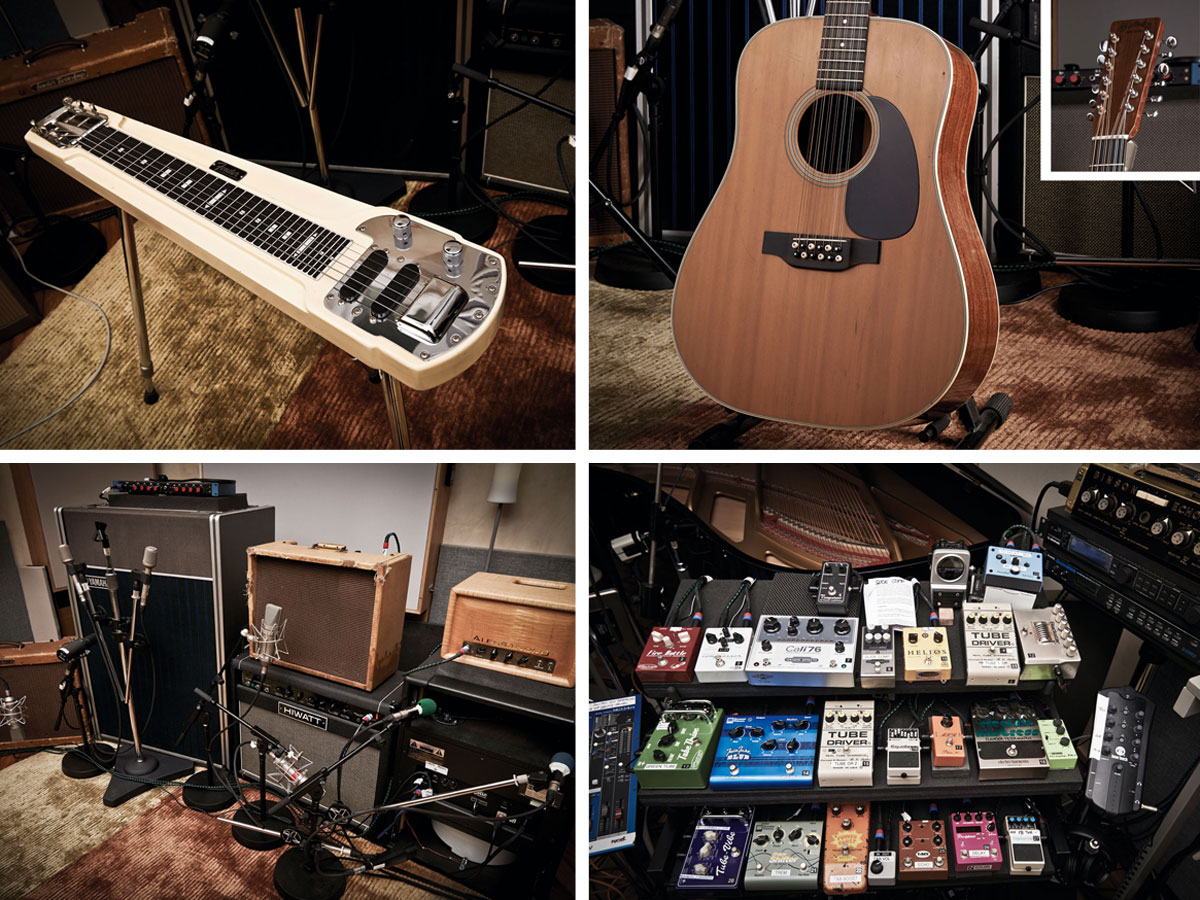
Introduction
We join David Gilmour’s long-serving tech Phil Taylor to examine in full detail the instruments, amps and effects that the Pink Floyd legend used to summon up the rich soundscapes of The Endless River.
David Gilmour clearly likes water. His famed houseboat studio, Astoria, is moored on the Thames near Hampton. Today, Guitarist is at his other studio, Medina, near Brighton and overlooking the Channel. Aptly, it was these two venues that were employed to record the bulk of the final Pink Floyd studio album, The Endless River.
"Gilmour has his own custom control room rack, with switching that allows him to turn on any combination of amps in the live room"
Gilmour has declined to talk any more about The Endless River: he thinks there’s been “too much fuss” already. But he has sanctioned his guitar technician Phil Taylor to guide Guitarist through some of his studio set-up. Prepare to be boggled.
Medina is smaller than you may expect for a musician of Gilmour’s legendary status, but size isn’t everything: Medina is bespoke to Gilmour’s needs.
“It was a derelict storage unit when David bought it three years ago,” Phil Taylor explains. Once the building’s ‘shell’ had been renovated, Taylor got to work on bespoke appointments. The control room’s mixing desk is hand-built and on wheels so Taylor can access its rear for servicing.
Gilmour has his own custom control room rack, with switching that allows him to turn on any combination of amps in the live room - if he fancies recording in the control room. Even the wiring of Medina is custom-designed by Taylor.
He explains: “Because David records with single-coil guitars - his Strats, his Teles - particular attention was paid to the electrical installation to avoid creating mains power ‘radiating’ and interference.
The entire building was wired in shielded mains cable. All earthing is connected to the regular main ‘company’ earth - except the audio-technical earth, which has two 60-foot copper rods sunk into the ground.
All lighting systems are run in 12 volts DC, and the technical studio power is derived from a balancing transformer.”
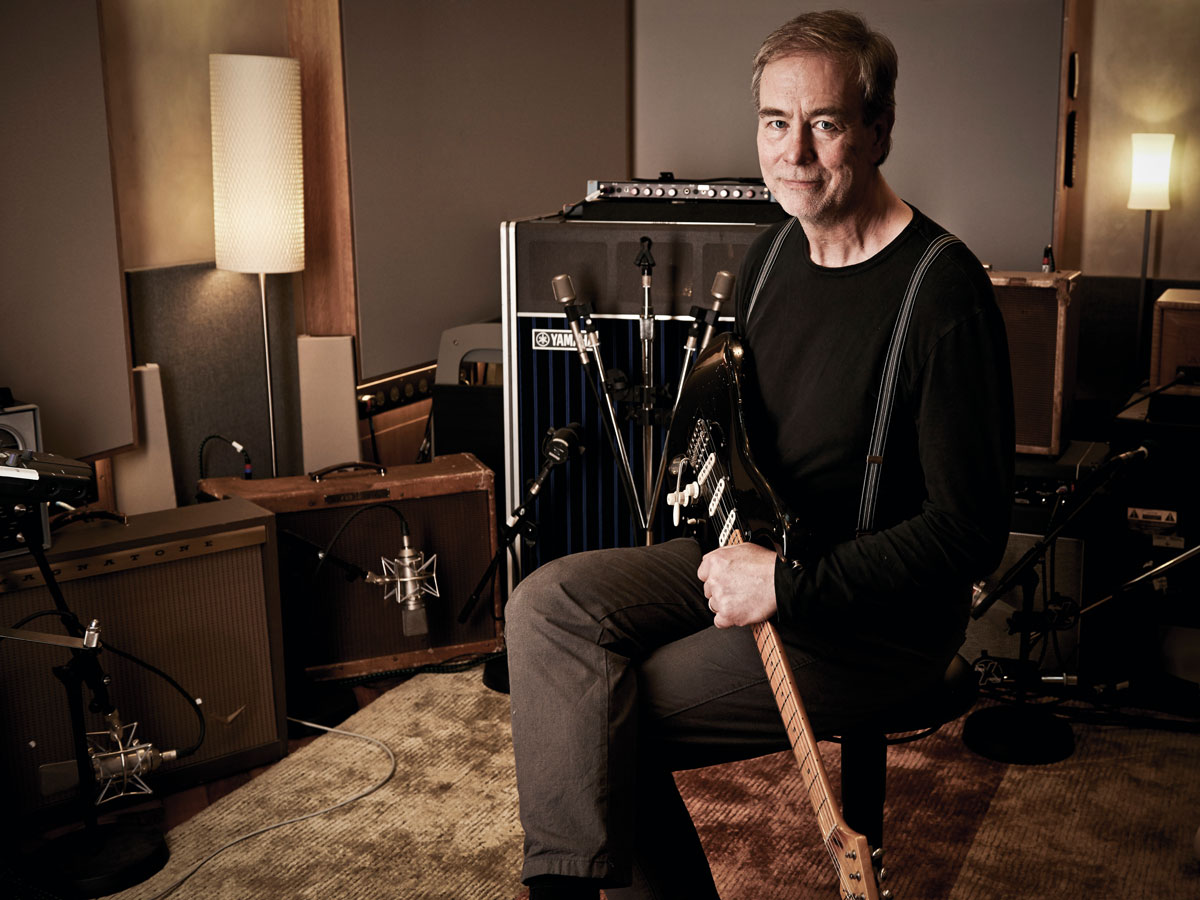
Phil Taylor
Phil Taylor has been David Gilmour’s guitar technician since 1974. He is also Pink Floyd’s warehouse and studios manager.
He oversaw Fender’s 2008 introduction of the David Gilmour Signature Stratocaster. Taylor’s definitive book, The Black Strat, is now in its third updated edition.
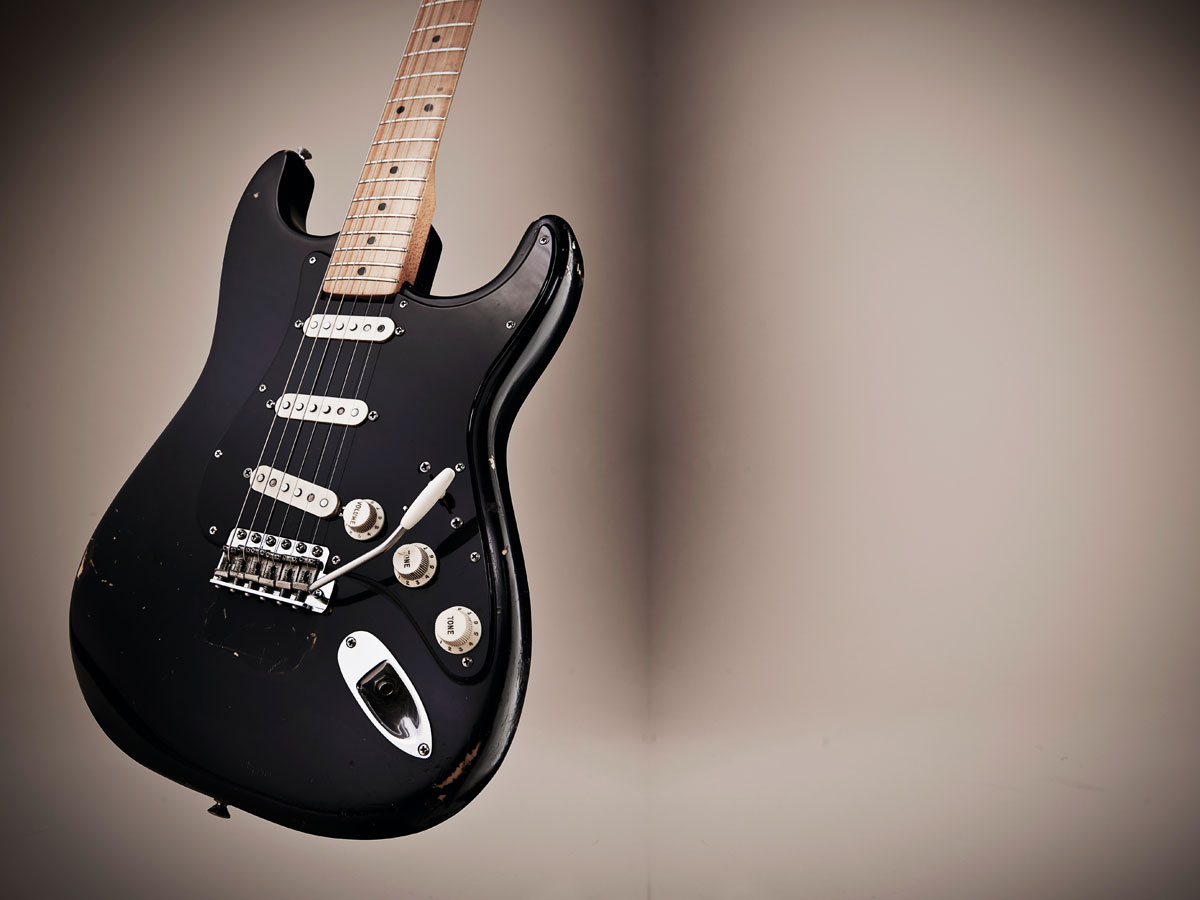
The Black Strat
We start our studio tour with what is unarguably David Gilmour’s most celebrated guitar - which is something of a ‘mongrel’. He bought the Fender from Manny’s Music store in New York in May 1970 during Pink Floyd’s USA tour.
"The Black Strat was first played by Gilmour at the Bath Festival in June 1970"
Gilmour had, just weeks earlier, bought his first black Fender Strat at Manny’s, but it was soon stolen, along with much of Floyd’s rig. Floyd cancelled their remaining US dates, but David again visited Manny’s and bought this before returning to the UK.
The Black Strat was first played by Gilmour at the Bath Festival in June 1970. Serendipitously, Phil attended the show as a punter - four years before he began tech’ing for Floyd.
Gilmour replaced a lot of his older Fenders in the 80s with Fender’s then-new 1957 reissues, and The Black Strat was on display at the Dallas and Miami Hard Rock Cafes until 1997, after which Gilmour played it for Floyd’s 2005 Live 8 show. It remains his most iconic instrument.
Hard knock cafe
As mentioned, the Black Strat hasn’t remained by David Gilmour’s side continuously. Phil Taylor explains that it was a switch of vibrato system that prompted the guitar’s temporary fall from favour.
“When we put the Kahler on, it seemed to deaden the sound somewhat. It just fell out of David’s favour when the new ’57 reissue Strats came out. So David agreed to loan the Black Strat to the Hard Rock Cafe.
“We were on tour with Pink Floyd, ’87 or ’88, and went into Dallas Hard Rock Cafe and saw it on the wall. [Editor’s note for Black Strat spotters: it was later displayed in Miami’s Hard Rock Cafe]. In time, we asked for it back.
“I called the Hard Rock head of memorabilia, but they said, ‘But we own it, now.’ No you don’t! I had all the paperwork that said it was a loan. So we eventually got it back. But it came back with the Animals tour-case missing, the knobs gone, and filthy. But I put it all back together and put it in the studio.”
Would David play it? He was used to the Red Strats by then.
“David didn’t use the Black Strat again until I suggested he try it at the Live 8 rehearsals. ‘Oh, alright!’ David says. But when he started playing it again... we suddenly went from that EMG sound to the single coils. That was it. He was back to the Black Strat.”
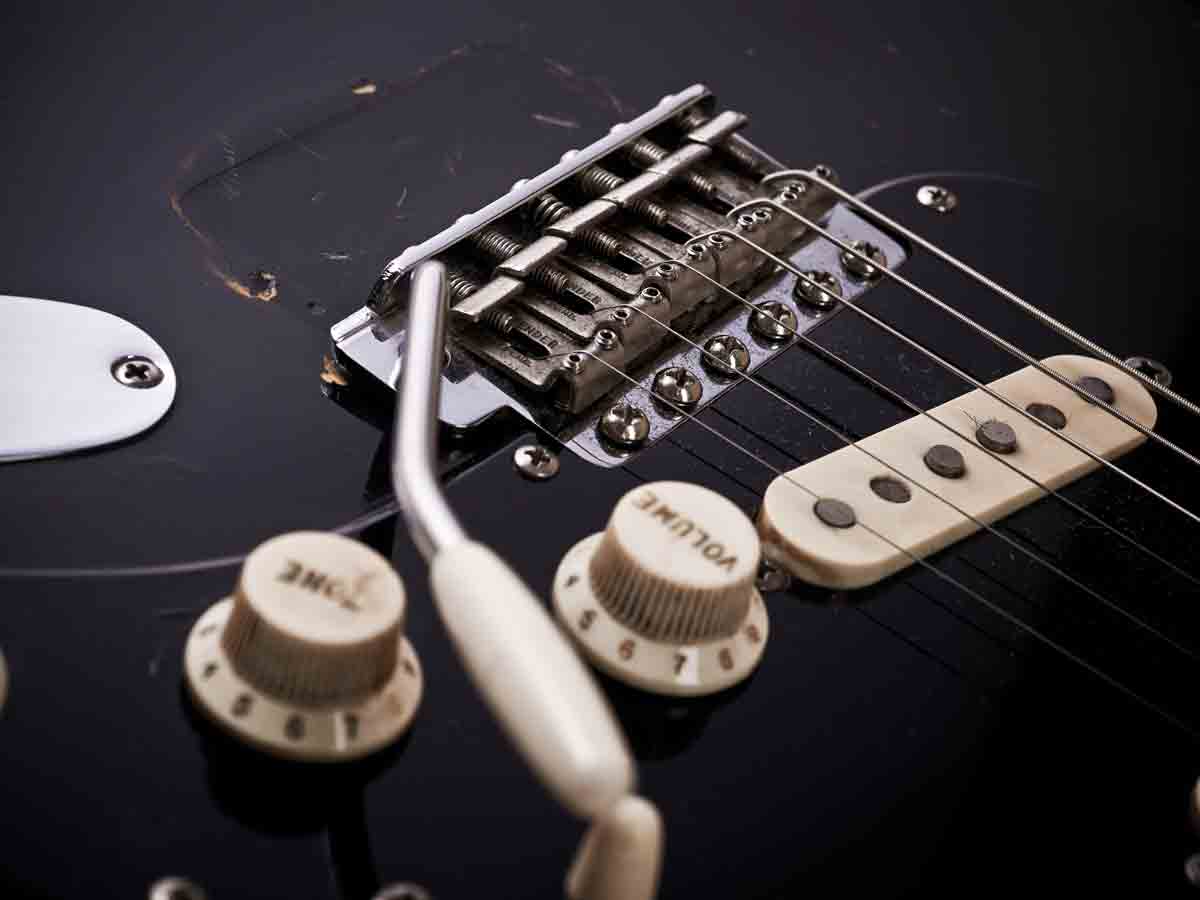
Mod squad
As a close-up examination of the original Black Strat attests, it is a much-modded guitar. It was originally a Fender 1968 to ’69 alder body with black painted over the original Sunburst.
It had a Fender late ’60s maple neck (large headstock) and 21 frets, but a rosewood-necked version features on The Dark Side Of The Moon and Wish You Were Here. To muddy the waters still further, it later had a Charvel neck fitted!
"This guitar features on some huge tracks, including Money, Shine on You Crazy Diamond, Comfortably Numb and many other Floyd classics"
When it came back from Hard Rock cafe, it was damaged and with knobs missing, so the mods have continued. See the next few pages for a rundown of the current features of this changeling Strat.
In terms of prior discography, this guitar features on some huge tracks, including Money, Shine on You Crazy Diamond, Comfortably Numb and many other Floyd classics.
See it in the concert film Live At Pompeii when it was ‘new’ for Gilmour, with white scratchplate.
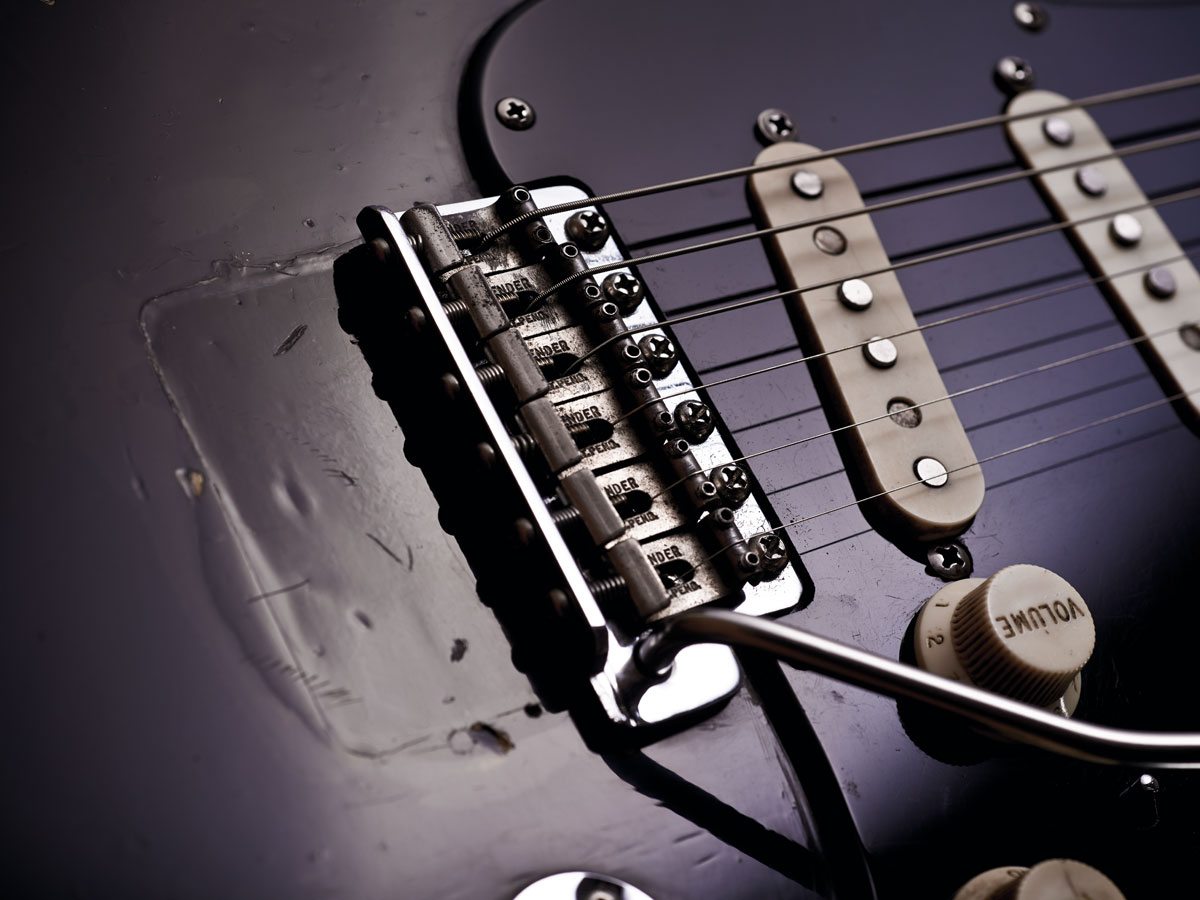
Bridge
Examining the guitar, you can clearly see evidence of old routing work, which has since been filled in for the once-fitted Kahler vibrato.
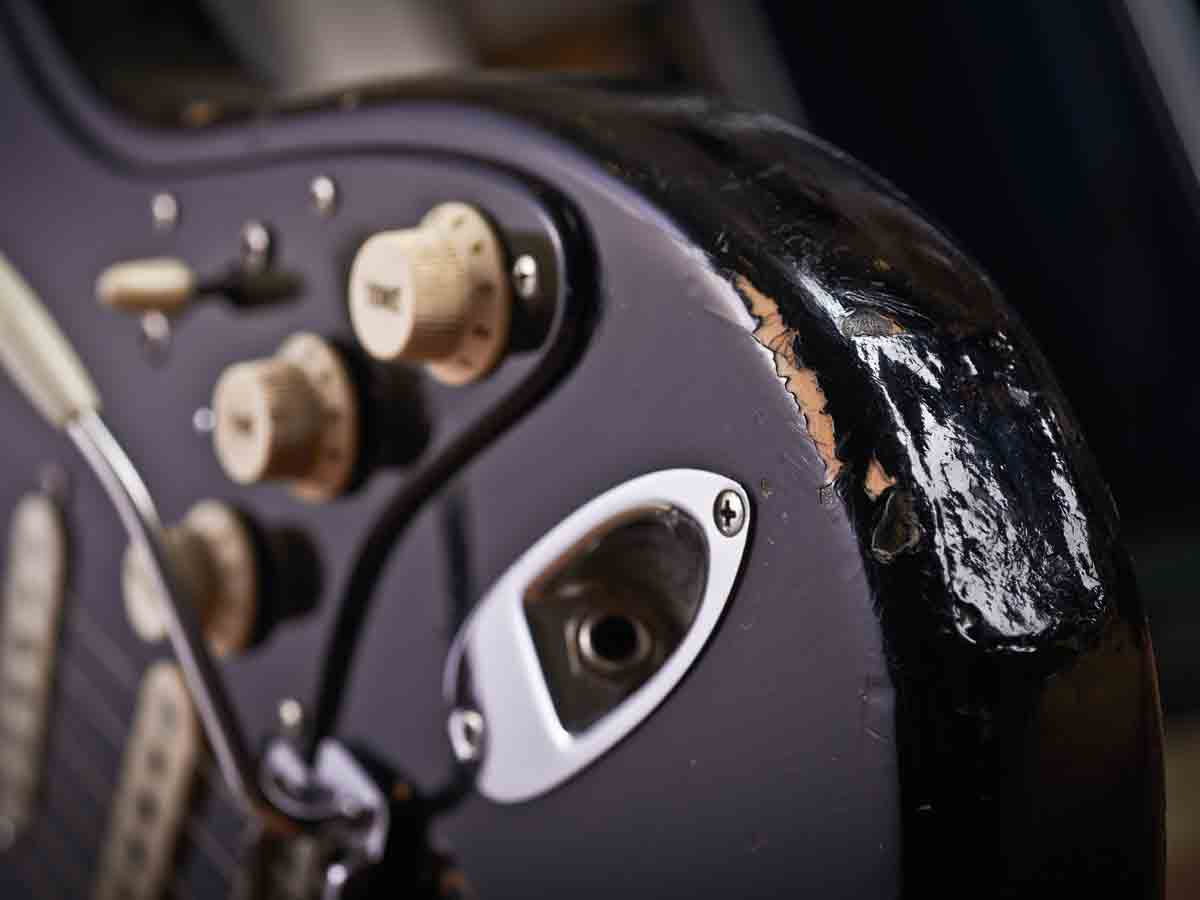
Ex-XLR socket
In the 70s, Gilmour fitted an edge-mounted XLR socket to send the signal to a fuzzbox then back to the guitar - also since removed and filled in.
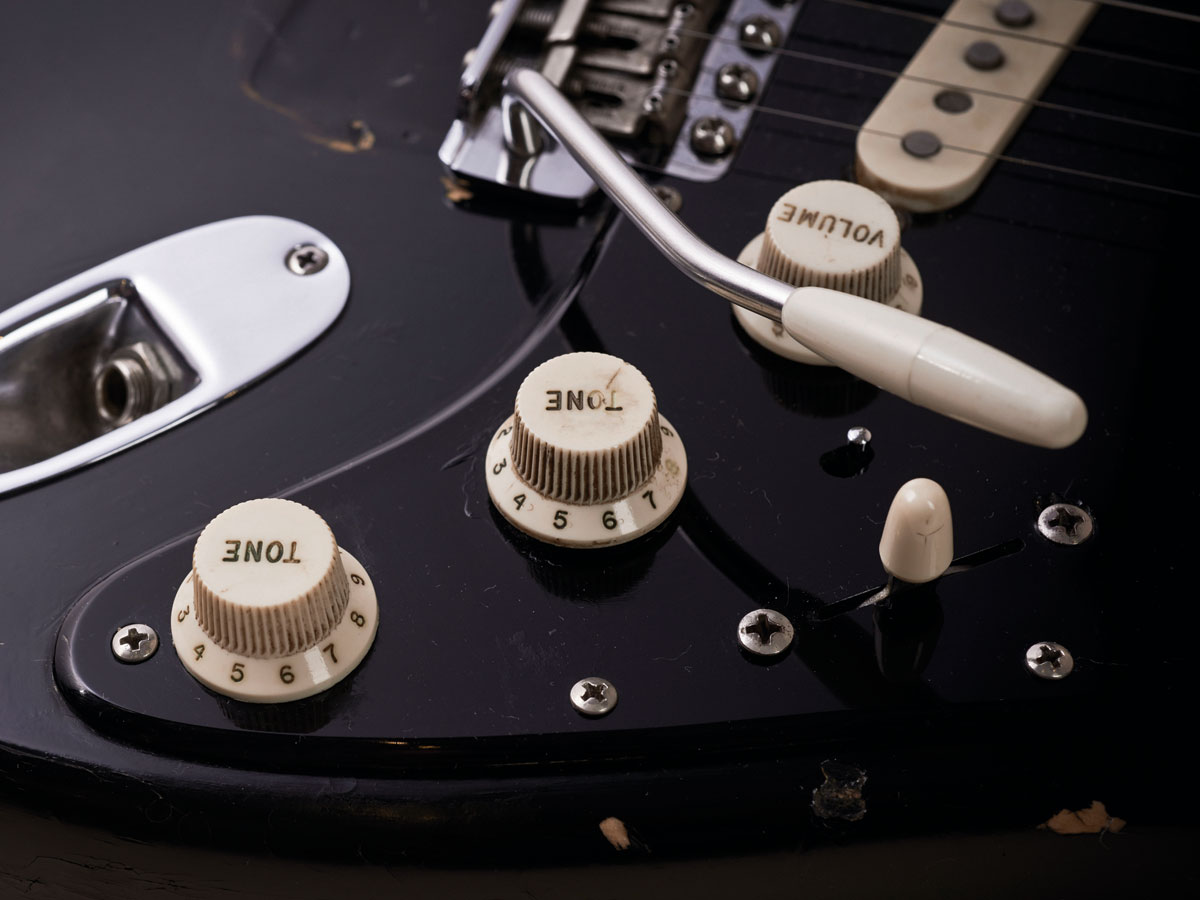
Scratchplate
The black scratchplate was added in 1974 and was custom-made, as Fender didn’t then make them.
The 5-way pickup selector (replacing the original 3-way) arrived in 1985. The mini-toggle just below the pots allows independent switching-in of the neck pickup “for a more Jazzmaster-like tone”.
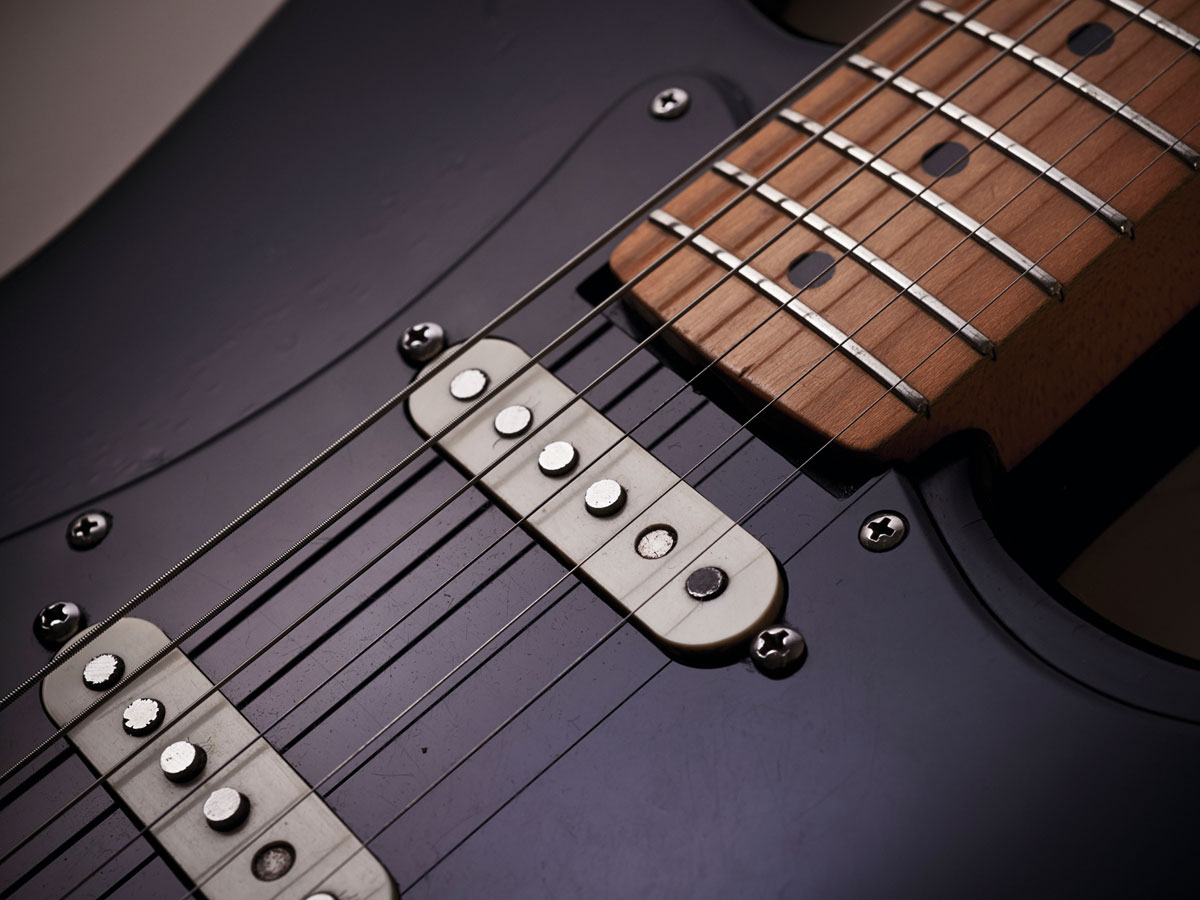
Neck pickup
The neck and middle pickups are dated 1971 - while the whole pickguard assembly comes from a ’71 ‘bullet truss rod’ Fender Strat in 1973.
Meanwhile, the bridge pickup is a Seymour Duncan custom-wound SSL-1C, installed in 1979. It replaced a DiMarzio FS-1.
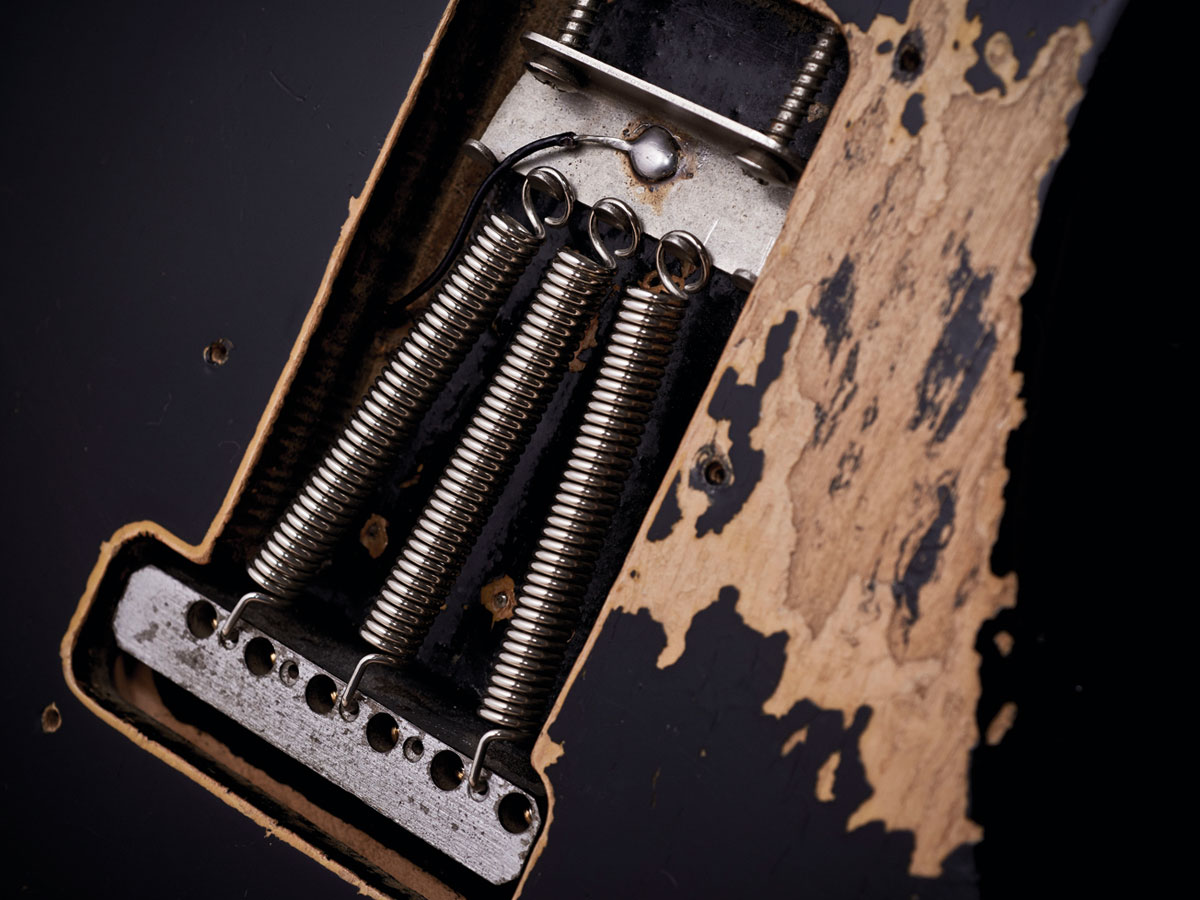
Rear
After the tonal properties of a Kahler vibrato fitted to the Black Strat were found wanting, the original three-spring vibrato was fitted to the guitar.
Note the extensive belt-buckling that the body’s reverse has picked up during years of hard use.
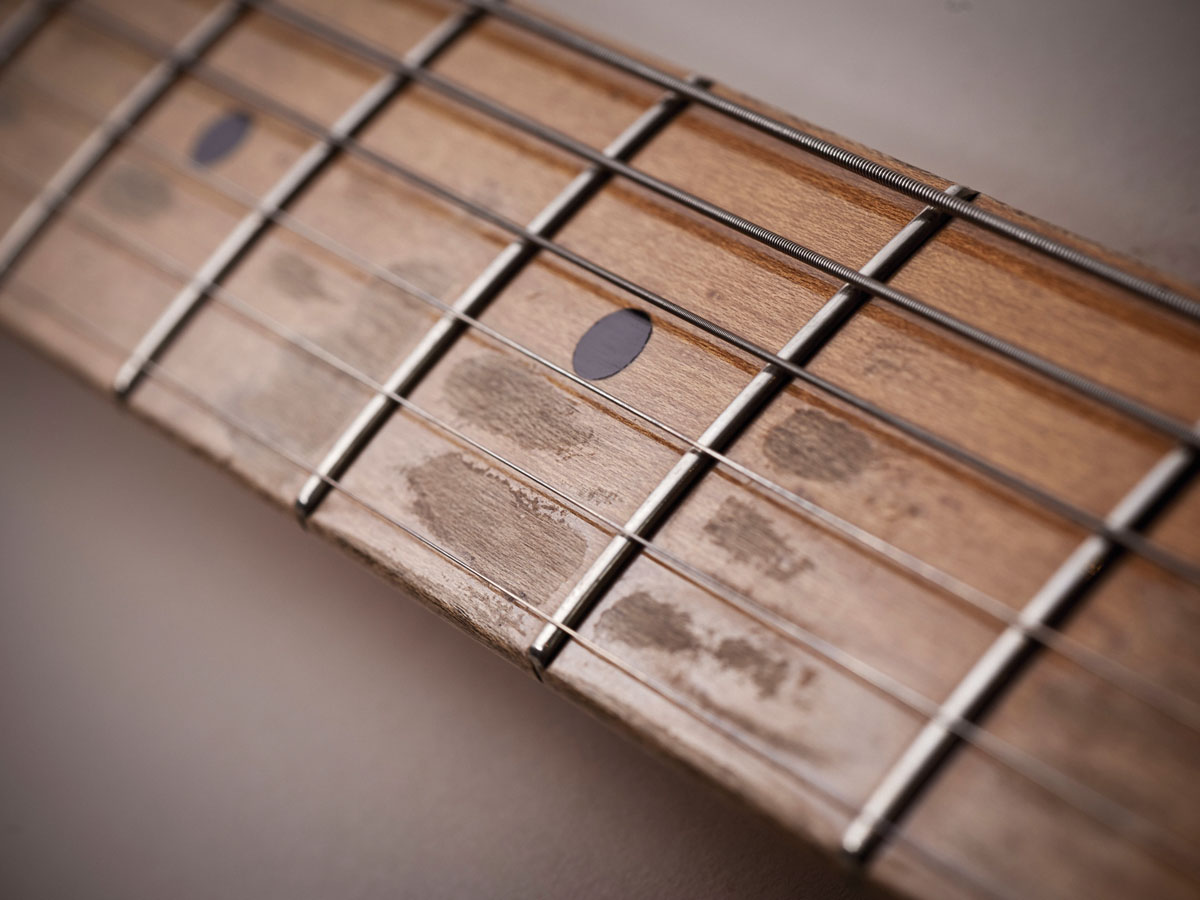
Neck
Currently, the Black Strat is fitted with a Fender 1983 ’57 reissue c-shape maple neck (from one of David Gilmour’s cream Strats) with 7.25” radius fingerboard and 21 vintage-style frets. Tuning is handled by Fender/Gotoh vintage-style machineheads.
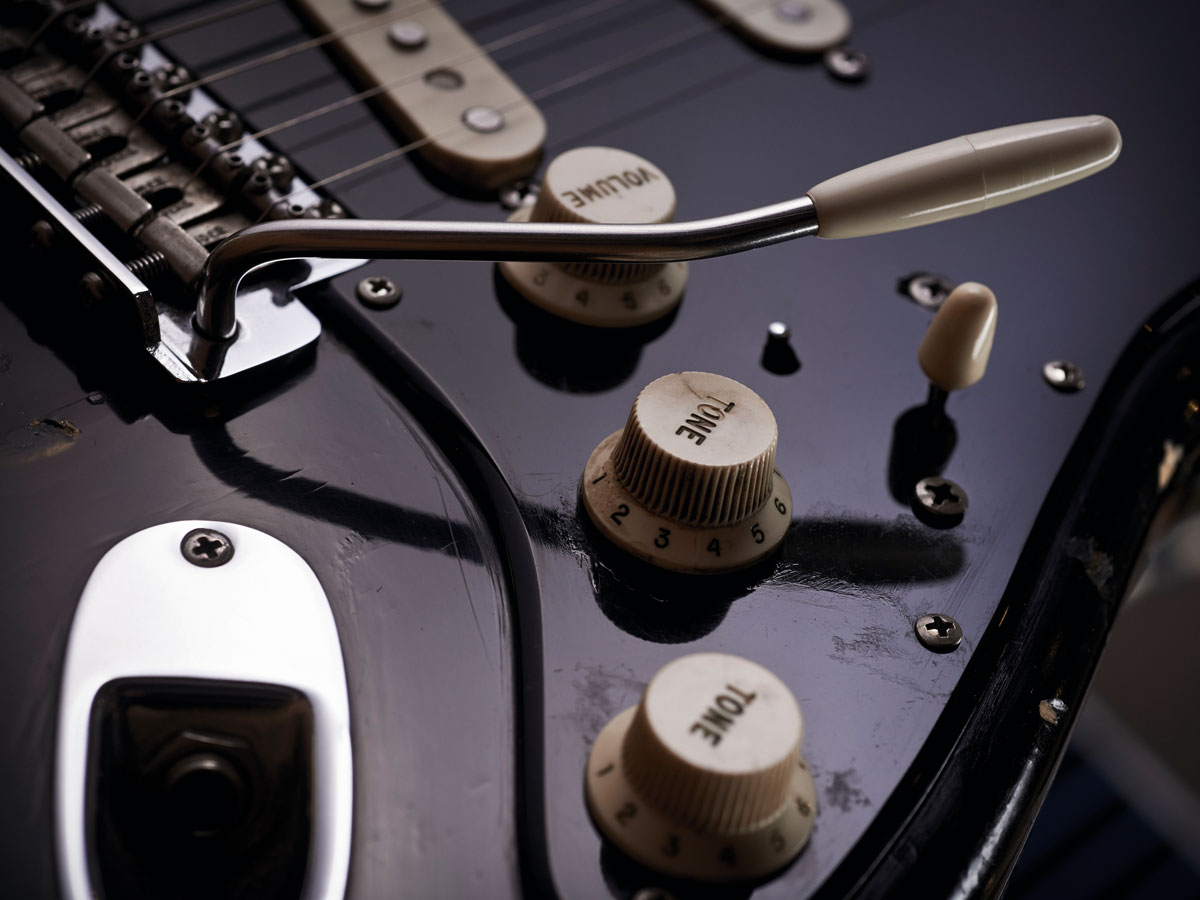
Vibrato arm
Note the shortened vibrato arm, which measures 4.25-inches.
"I originally just hacked the ends off. The arms are screwed in tight so it never ‘flops’"
“They’re nothing special. Fender make these short arms now, but I originally just hacked the ends off. The arms are screwed in tight so it never ‘flops’, that’s one thing," says Phil.
"And David likes to have the end of the tip in the crease of his palm. He doesn’t seem to plan whether he plays finger vibrato or arm vibrato, or a combination of the two, at any one time.
"But with a longer arm, he may have to play closer to the neck. That would be more of a separate action to david. This is more ‘integrated’ in the way he plays. He doesn’t often play electric guitars without a trem.”
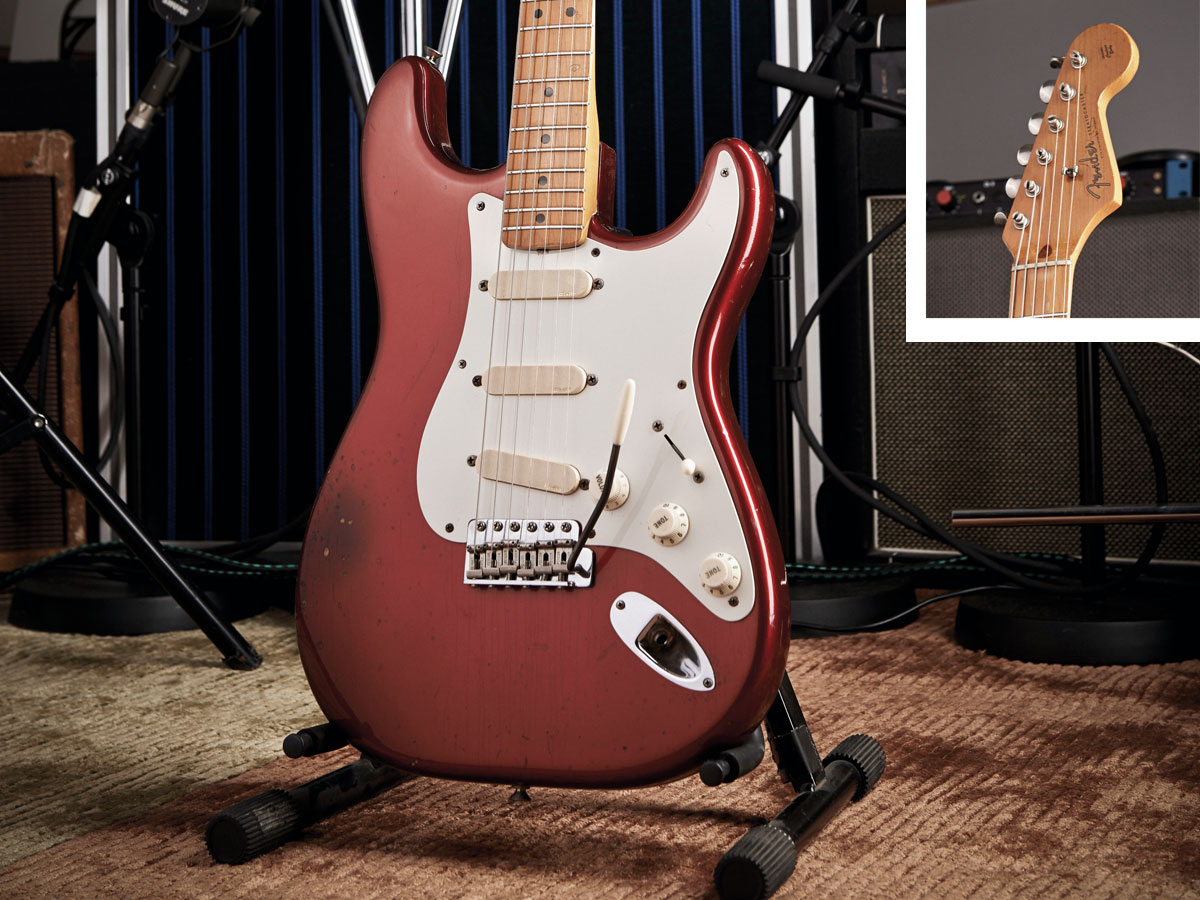
Seeing Red
Associated with post-Roger-Waters-era Floyd and solo work, Gilmour bought a bunch of new Fender Strats before his 1984 About Face solo album and tour, as he didn’t want to take the Black Strat and others on the road.
Purchases included a Fiesta Red 1983 ’62 Reissue with white pickguard and a rosewood neck, two Cream 1983 ’57 Reissues [see the current Black Strat neck] and a Candy Apple Red 1983 ’57 reissue with white pickguards and maple necks. His main Red Strat is the Candy Apple Red guitar pictured above.
"Like the Black Strat, the Red Strat has been extensively modded. Gilmour eventually replaced the single coils on his main Red with active EMG pickups"
Phil Taylor: “We went up to the Arbiter warehouse in London and we tried them and bought a few. Very nice guitars. David just started using them instead of his Black Strat. For a long time, he was happy with that sound. Then again, David can get a good sound out of anything.”
The ’57 reissues are denoted v57 by Fender, but that refers to “Vintage”, not the neck - these ’57 reissues have C-shaped necks, not V-profiles. Got that?
Like the Black Strat, the Red Strat has been extensively modded. Gilmour eventually replaced the single coils on his main Red with active EMG pickups - 1979-made forerunners of what became the signature DG20s (DG still employs the originals).
The EMGs feature an EXP control boosting treble and bass and an SPC control, boosting the midrange for a humbucker-esque tone. Gilmour also added his ‘custom’ 4.25-inch vibrato arm.
As well as being used on The Endless River, it also featured extensively on A Momentary Lapse Of Reason and The Division Bell albums and tours, and some of On An Island. It was also used in solo live shows for Shine On...
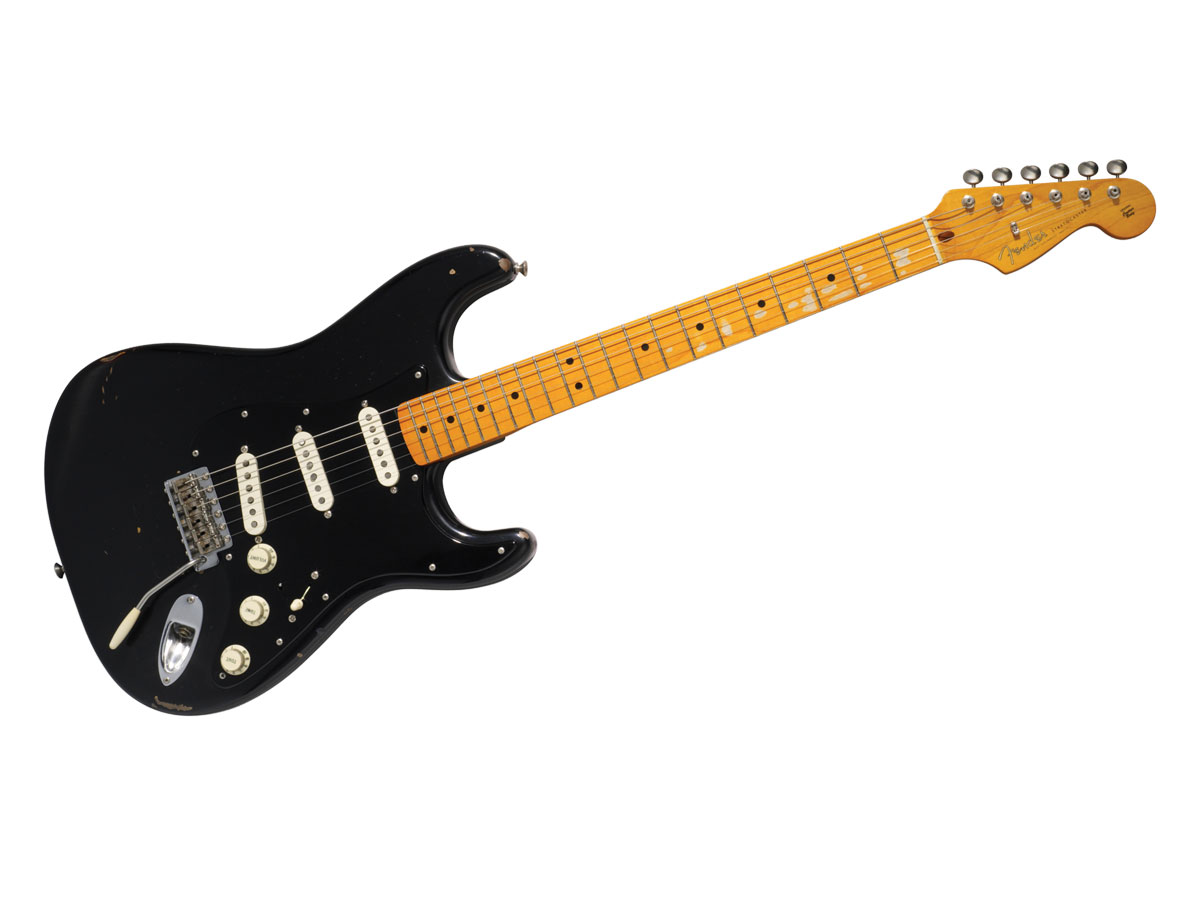
Replica Strats and signature models
In addition to the real thing, David began using two replica versions from 2008 onwards - a Relic (with all the battered bruising of The Black Strat) and a cleaner-looking NOS (New Old Stock) model. They’re as close as most of us will get to the iconic original.
Phil Taylor explains. “Fender asked me and David about this over 20 years ago. But David just wasn’t interested. But when they asked in 2006, David finally said: ‘Well, what do they want to do?’
"If Fender were going to do it, David insisted it had to be of that same quality, but affordable"
"Fender wanted to do 200 or so really high-priced models. But David didn’t want to do copies of The Black Strat that were only available to rich people who’d buy it and just put it in their closet. If Fender were going to do it, David insisted it had to be of that same quality, but affordable. So there was a bit of negotiation.
“And David didn’t want to make the guitar a limited edition model, either - he wanted it to be available over a number of years. So all credit to David for insisting that it wouldn’t be a limited edition, and both the NOS and signature versions of the guitar were all available at the same time.”
Of Fender’s replicas of The Black Strat, Phil Taylor adds: “Fender first sent a test guitar, which was quite interesting. Fender’s master builder, Todd Krause, sent this guitar that had the side of the body removed in order to be able to swap out pre-wired pickguard assemblies in seconds to enable us to do pickup comparisons. They sent seven versions for us to try.
“I spent some time with David going through these until he was happy with the pickups in relation to his original. They do sound very close, though the neck unit he settled on was slightly brighter.
“David was not so bothered about the exact replication of the body wear. It was left to me to ensure it was correct. When we finally had an acceptable prototype and we were happy with it, David said that he liked the idea of having one without all the wear - this became the NOS model. David insisted both were put on sale at the same time to give people the choice.”
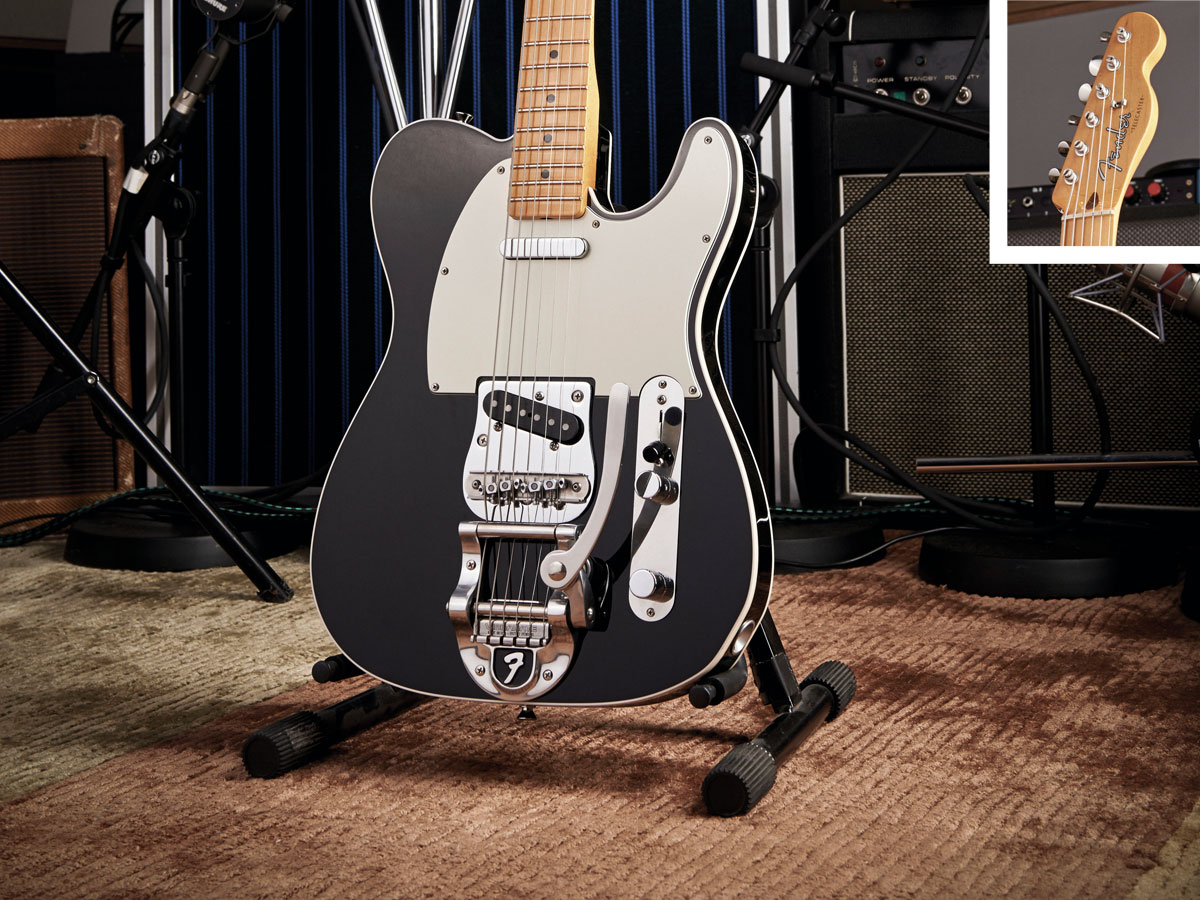
Fender Custom-Made Baritone Tele
PT: “David has a 1963 Fender Bass VI. It’s strung relatively light for a baritone. But it’s still a 30-inch scale, so I thought I’d get him a new one made. I wanted it to be more like a guitar, shorter scale, but it also had to have a vibrato on it. I talked to Fender, and they made two.
"The strings were unbalanced on the regular Fender Tele pickups, so I got Ron Ellis to make some custom baritone pickups"
“They have a 27-inch scale, so between a guitar and a bass. You can put lighter strings on these, it feels very nice. But I had to change a few things - I put a Vibramate String Spoiler on the back-end of the Bigsby and replaced the electronics with Callaham Cryo electronics. I wanted to get as much detail out of the strings as possible.
“The strings were unbalanced on the regular Fender Tele pickups, so I got Ron Ellis to make some custom baritone pickups. I was very pleased, thought it was marvellous. But it sat here for a year before David even picked it up!
"Only for The Endless River, was it played. We were here with (co-producer) Youth, who said David maybe needed a more baritone sound. David shrugged and says, ‘Okay... have I got a baritone?’ Finally, he played it.”
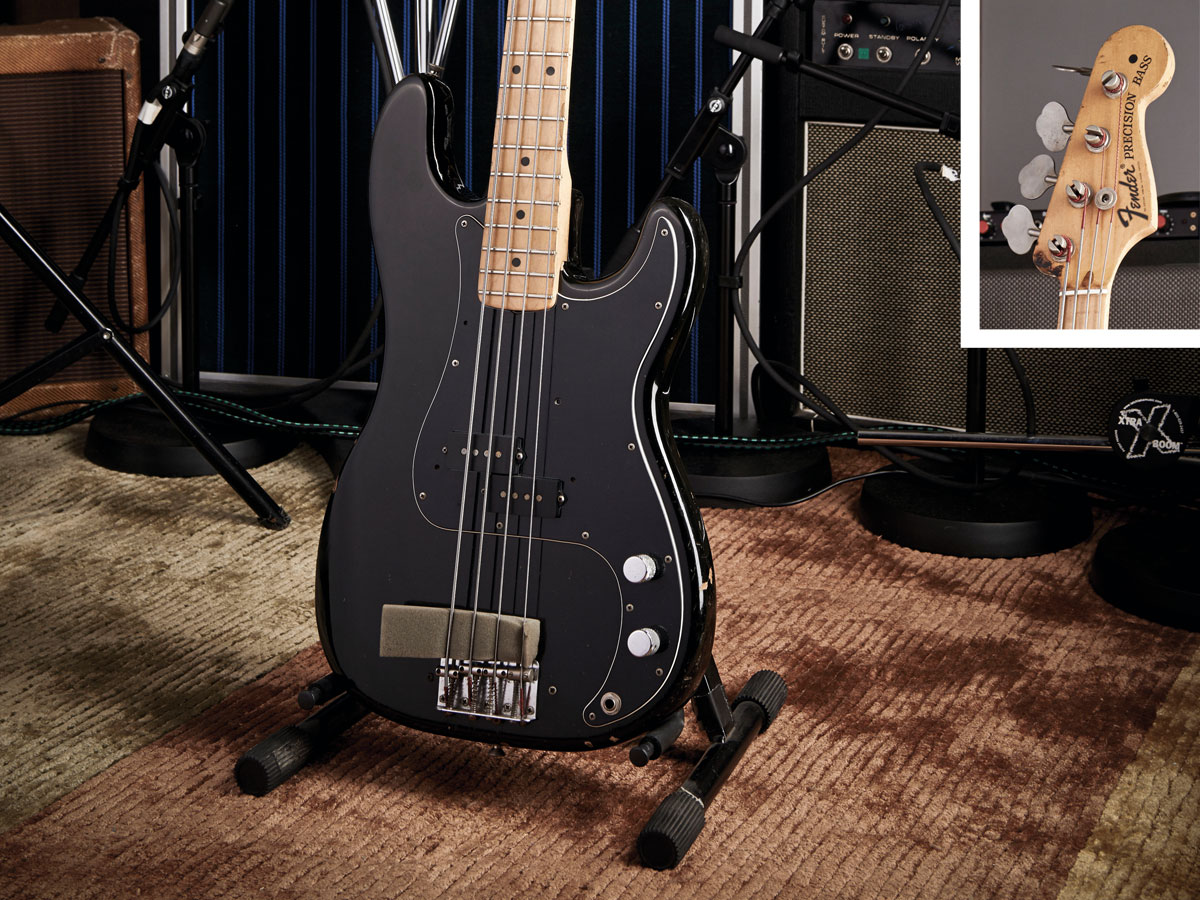
Roger Waters' Fender Precision Bass
When Roger Waters exited Pink Floyd, there were several ‘band-owned’ instruments. One of them was this 1970s Fender Precision played by Waters. David Gilmour kept it.
"It was played on Wish You Were Here and Animals, mostly"
PT: “This was the bass Roger had from 1974 to ’78. It was his main bass. It was played on Wish You Were Here and Animals, mostly. I replaced the pickguard to be black just before the Animals tour, 1976.
“Roger had three black basses - one with a rosewood neck, two with maple. But this was his main one. I just asked him if he fancied changing the pickguard to black, just like David’s Strat. Late ’76, I think. It’s a good bass. David plays it on The Endless River.”
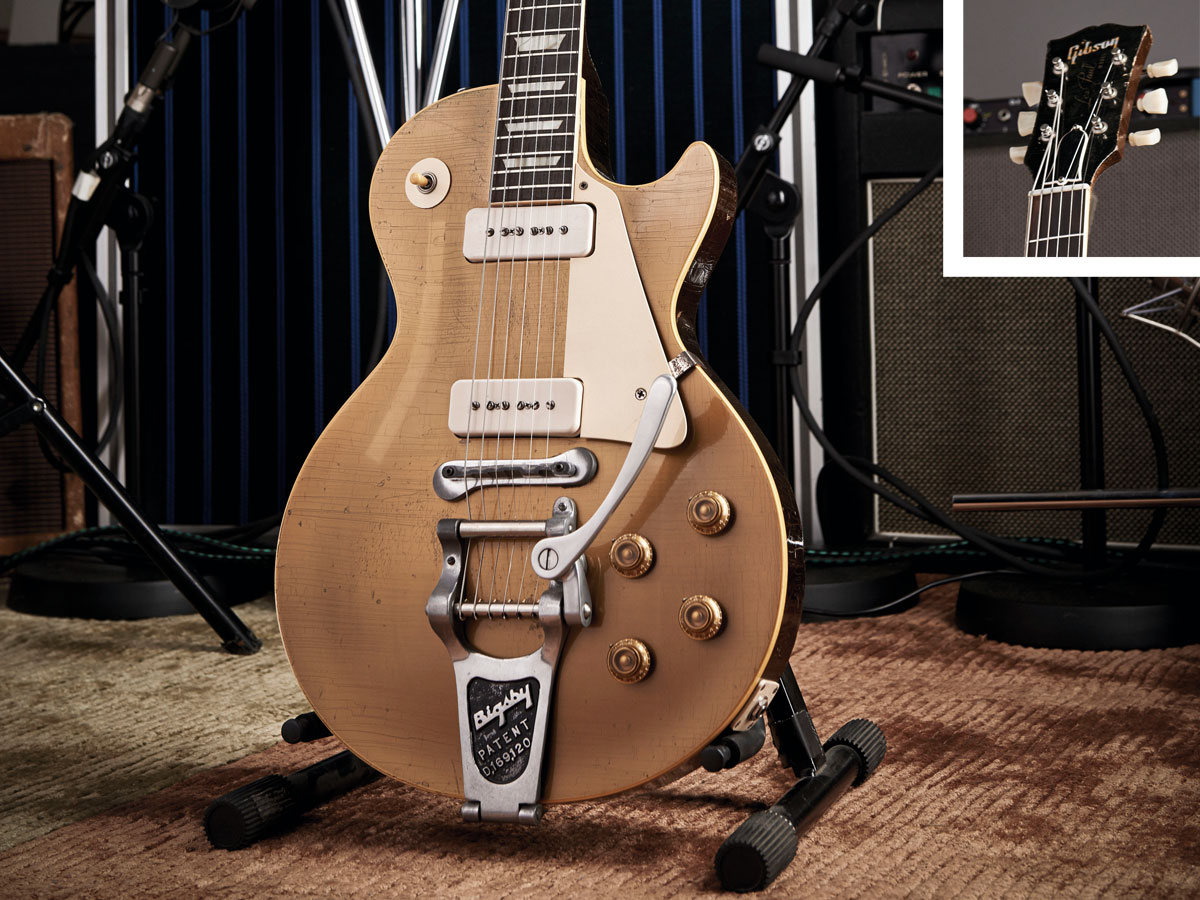
1956 Gibson Les Paul Goldtop
PT: “We got this because it had an original Gibson factory Bigsby on it. He has his ’55 (hardtail) Goldtop - that’s the one on Another Brick In The Wall (Part 2). But David wanted a Bigsby one. And he didn’t want a modified one, with a later-added Bigsby. He played this a lot on On An Island.
"You can hear this guitar on On An Island’s title track, in the first part of the first solo"
“It’s got P-90s. The only humbuckers David uses are on the Gretsch Duo-Jet - and although they are humbuckers, they sound more like single coil pickups. He also has a reissue Gibson Les Paul from about 2009, which has Rolph pickups and a Duesenberg trem.”
You can hear this guitar on On An Island’s title track, in the first part of the first solo. Note the P-90 pickups: “David generally doesn’t like humbuckers,” says Phil Taylor.
Key cuts for Gilmour Goldtops are the solo of Another Brick In The Wall (Part 2), Round And Around and Poles Apart on A Momentary Lapse Of Reason, A Great Day For Freedom from Division Bell, This Heaven from On An Island, Happiest Days Of Our Lives and One Of My Turns (The Wall ’80 to ’81 tour).
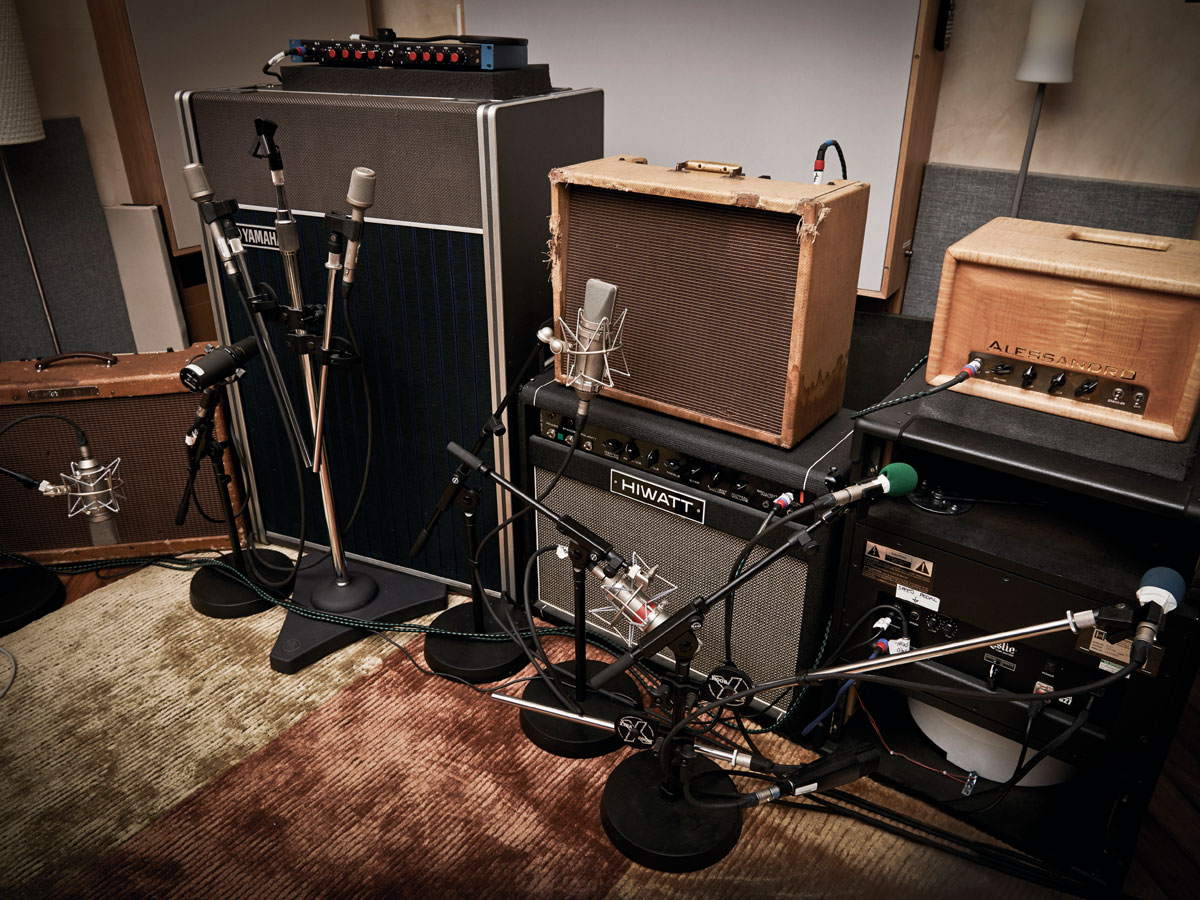
Amps
Left to right: 1958 FENDER Tweed Twin, 1976 Yamaha RA200 Rotary speaker with Alembic preamp, 1970s Hiwatt SA212, Alessandro Redbone Special, Leslie Model G27 cab
“These were David’s main amps on The Endless River,” comments phil Taylor on the beautiful array of vintage and modern amps in the studio’s live room. “He also used the Leslie Studio 12 cab with the Allesandro Redbone Special 55-watt model.”
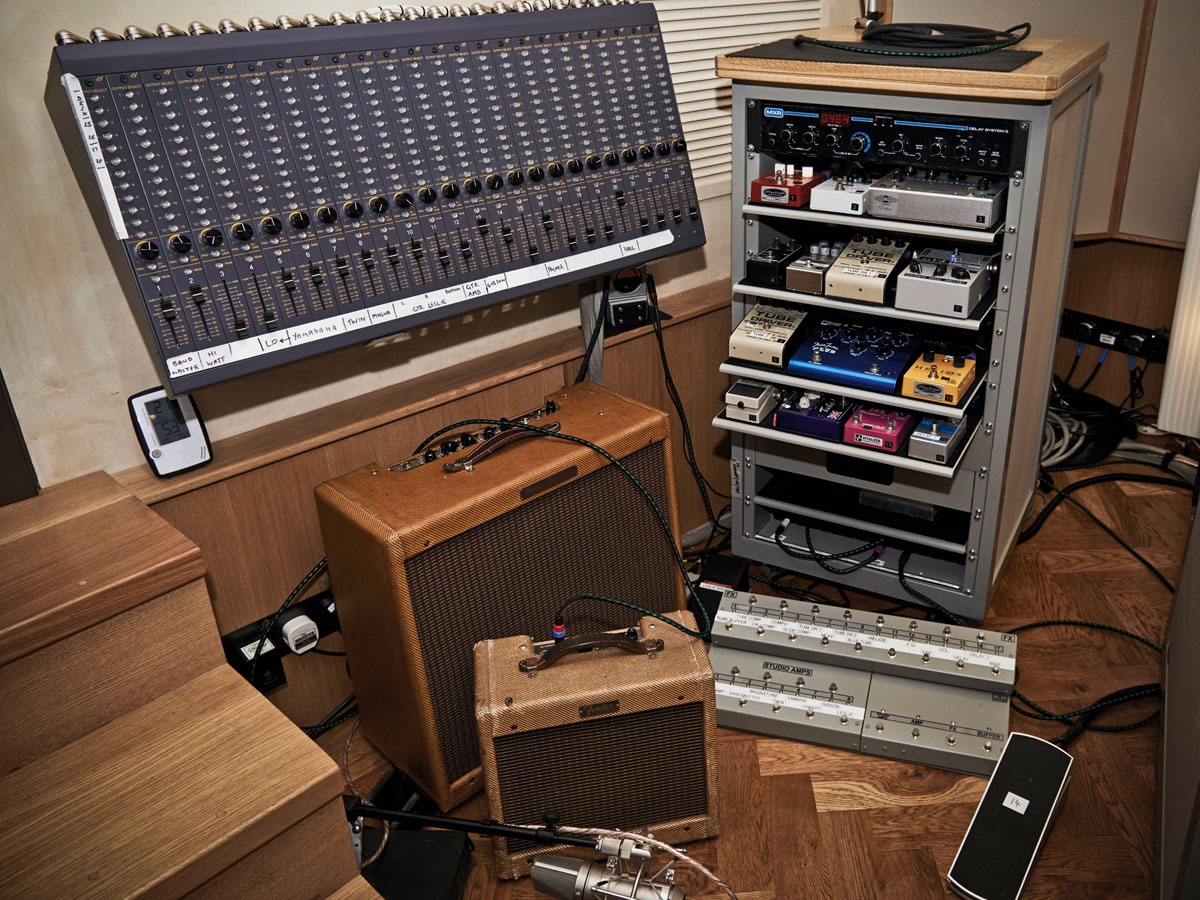
Wired for sound
The set-up is made more flexible by the addition of a rig that allows the amps to be operated from the control room (pictured, next). Note the Fender Tremolux and Champ amps.
“If David wants to record in the control room he can, without being in the live room. This [effects] rack is not a mirror of his main rack, it’s a system in its own right. But you can select the studio amps in the live space or from here.
"The Tim De Paravacini board (wall-mounted) is custom-made... Once David’s selected his amps, he can then control the amp mics, too"
"He can use the effects in here, or play in here and send the signal to the effects in the live room. It all means he can monitor what he’s recording in the control room. He can alter the speed of his Leslie cabinet, or the speed of the Yamaha RA200, all from here.
“The Tim De Paravacini board (wall-mounted) is custom-made: 24 tracks into 12. Once David’s selected his amps, he can then control the amp mics, too, plus a couple of ambient mics as well. And he can send all this direct to Pro Tools.
Is it complicated? “Not really. It’s actually very user-friendly. David can come in, hit four switches and the whole place powers up. Ready to go.”
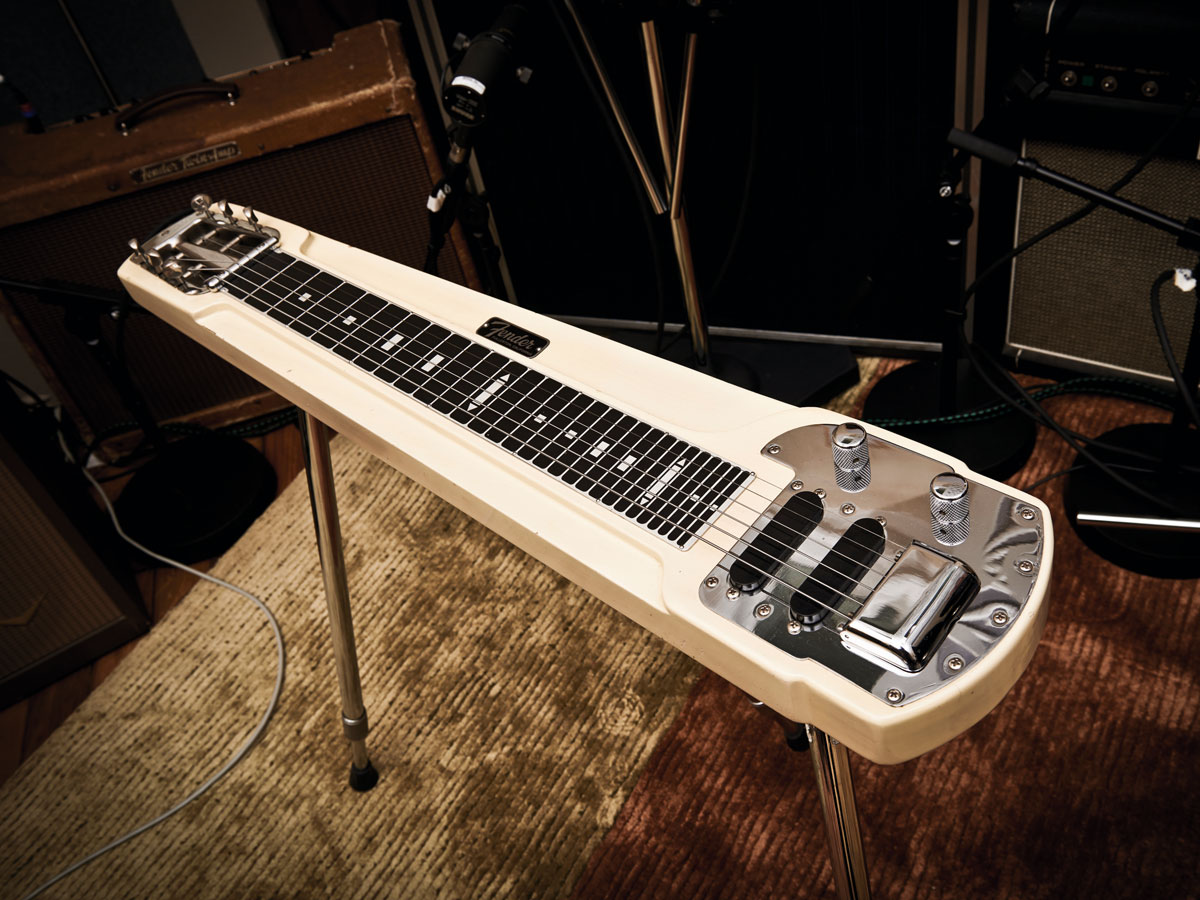
Fender Lap Steel
PT: “I don’t know the exact date of this Fender Lap Steel Deluxe. But if David is playing slide now, it’s usually on this. He doesn’t play ‘stand-up’ with a slide on his finger, he just doesn’t do it. The Fender is easier to sit down with and play.”
Gilmour also has an early 1940s Gibson EH-150 lap steel, played on High Hopes and Shine on You Crazy Diamond, plus Take A breath.
A Weissenborn Hawaiian-style lap steel was played on the song Smile. On Jam #166, featured on the Live In Gdansk DVD, he plays a Rickenbacker A-22 “frying pan” lap steel.
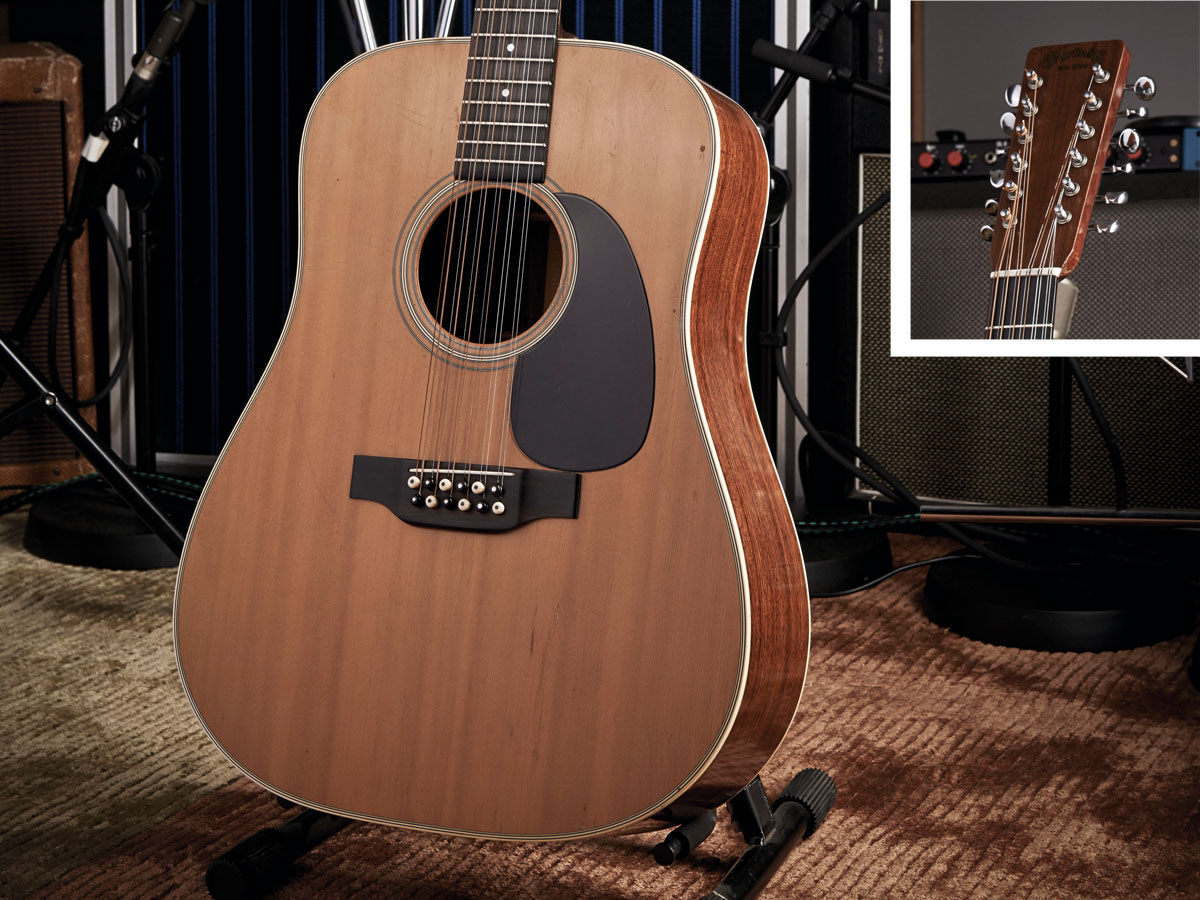
1971 Martin D-12-28
PT: “David bought this 1971 Martin D-12-28 second-hand off a friend of his. I don’t know exactly when - ’73 or ’74 - but prior to Wish You Were Here, obviously.”
Note that Gilmour played the lead parts of the song Wish You Here on another six-string Martin.
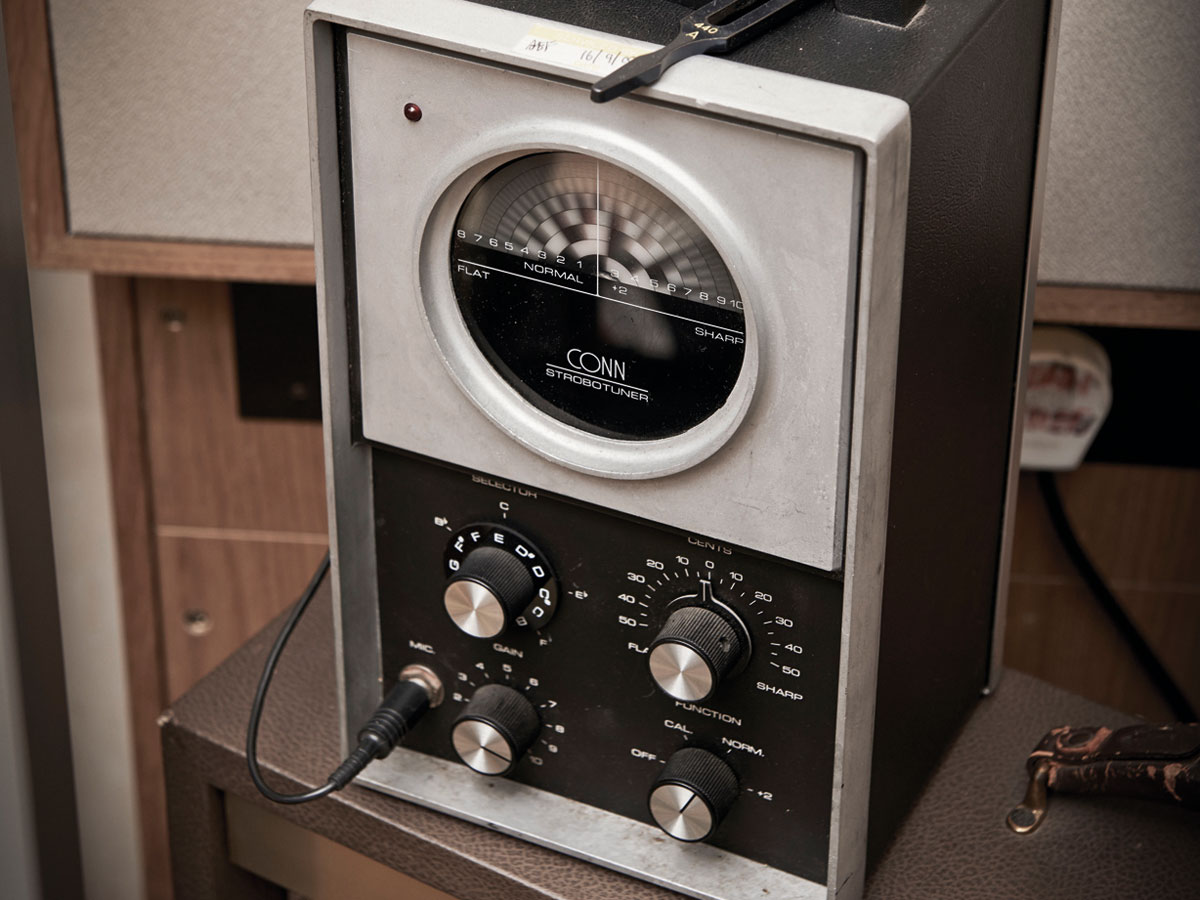
Conn ST-11 Strobotuner
The Conn ST-11 Strobotuner has been a regular fixture of Gilmour’s rig for years.
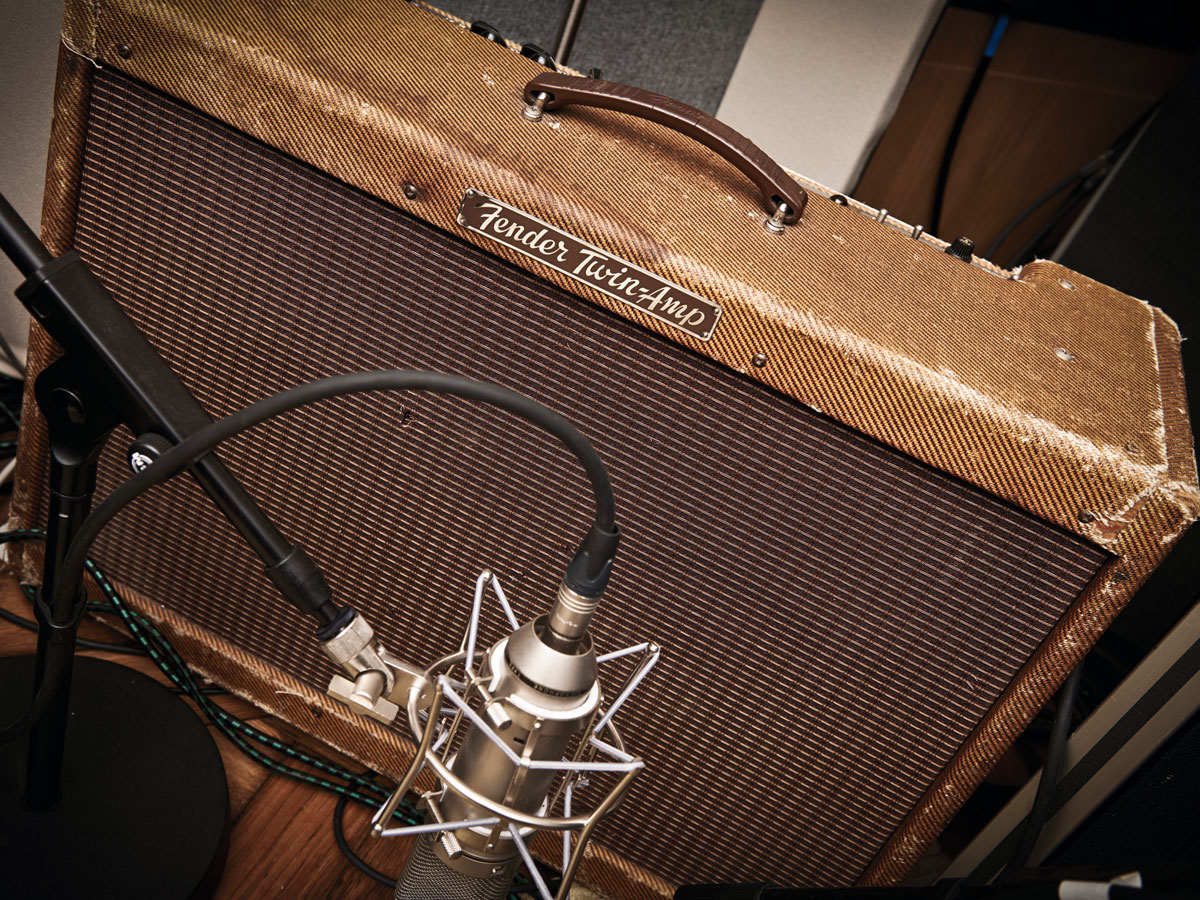
1958 Fender Twin
This well-used but beautiful 1958 Fender Twin, complete with weathered tweed finish, formed a tonal component of The Endless River.
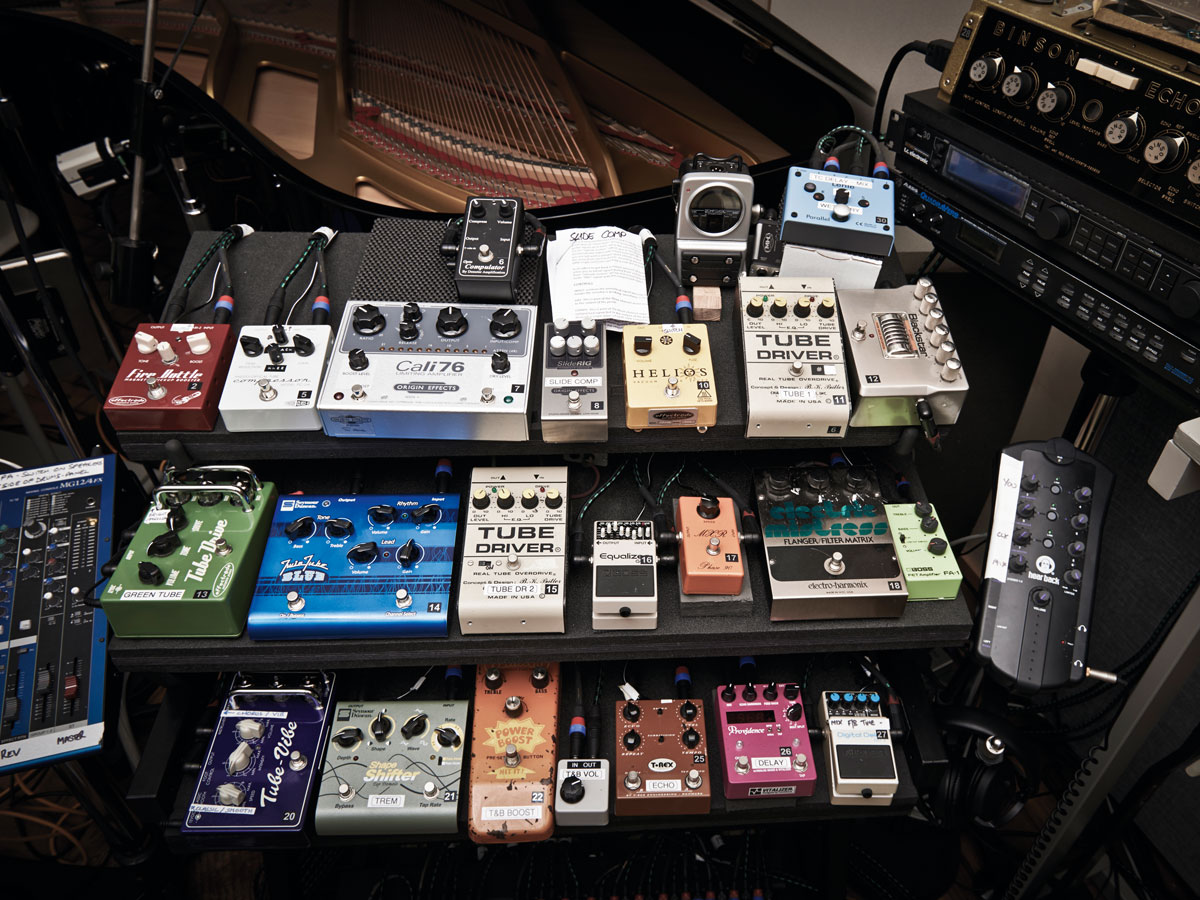
Gilmour's go-to pedals
A number of Gilmour’s go-to pedals are mounted on racks at hand-adjustable height in the live room, for convenience during use, but can be accessed from the control room, where - in case these weren’t enough - a second, variant rack of pedals is located.
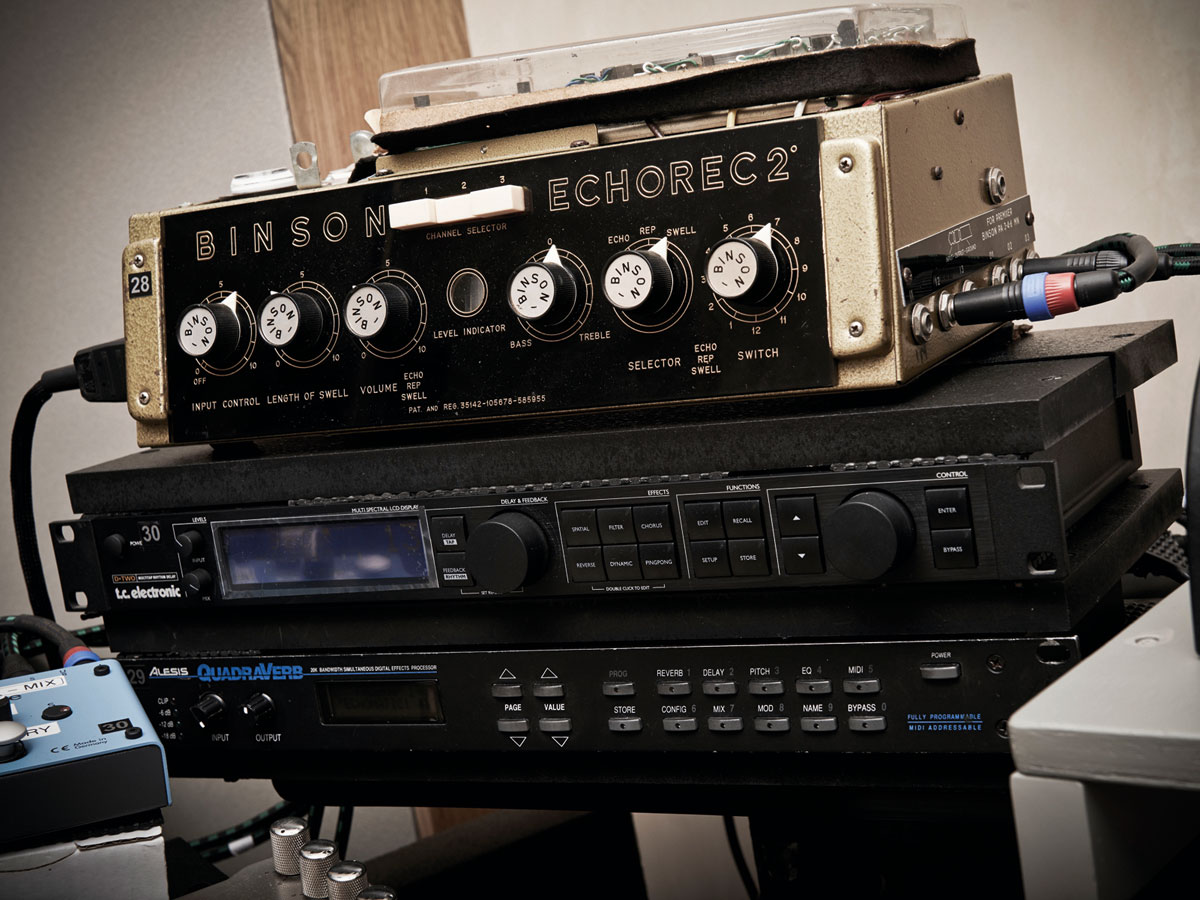
Binson Echorec 2
Echo and reverb effects are central to Gilmour’s sound, including this Binson Echorec 2 reissue that evokes the tone of vintage Floyd tracks.
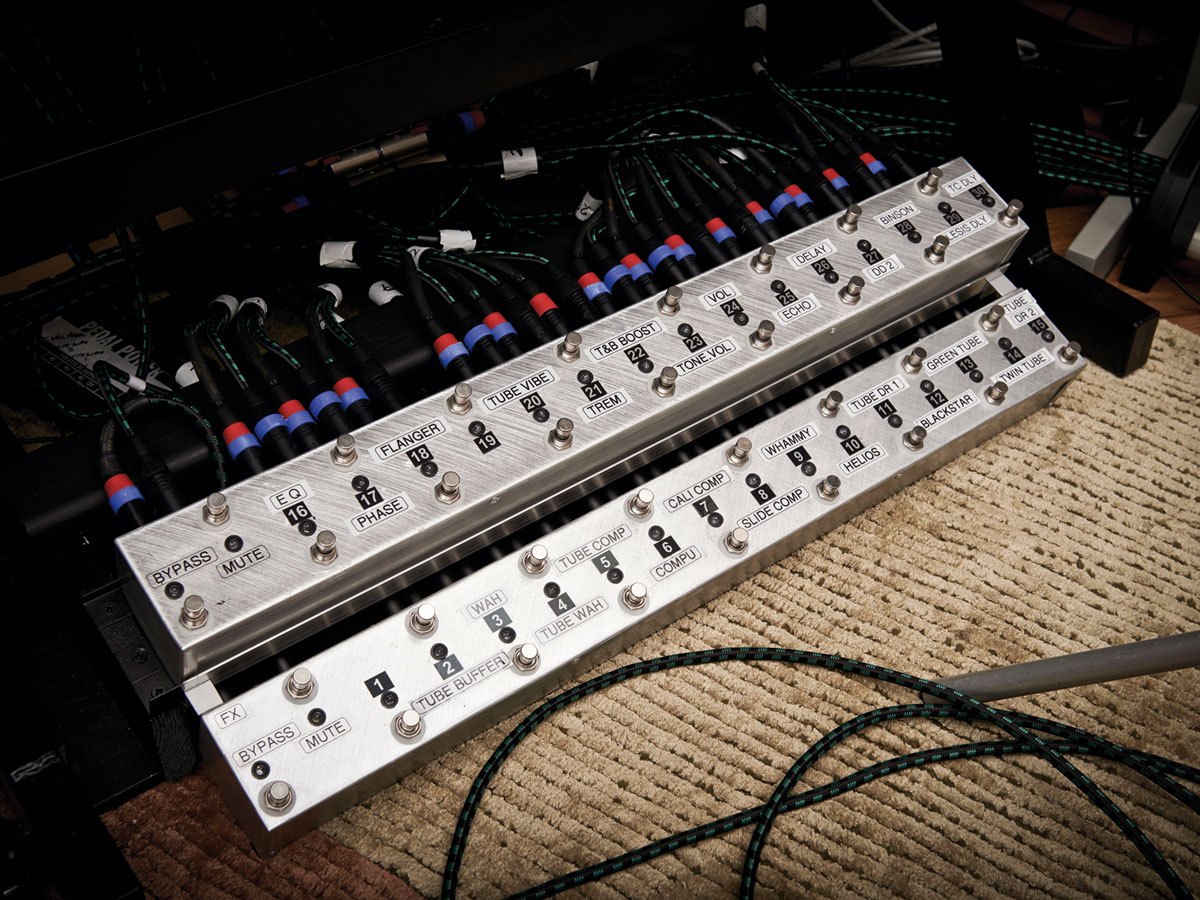
Custom switching - pedals
A custom switching system on the floor allows the racked pedals to be engaged easily via conventional footswitches.
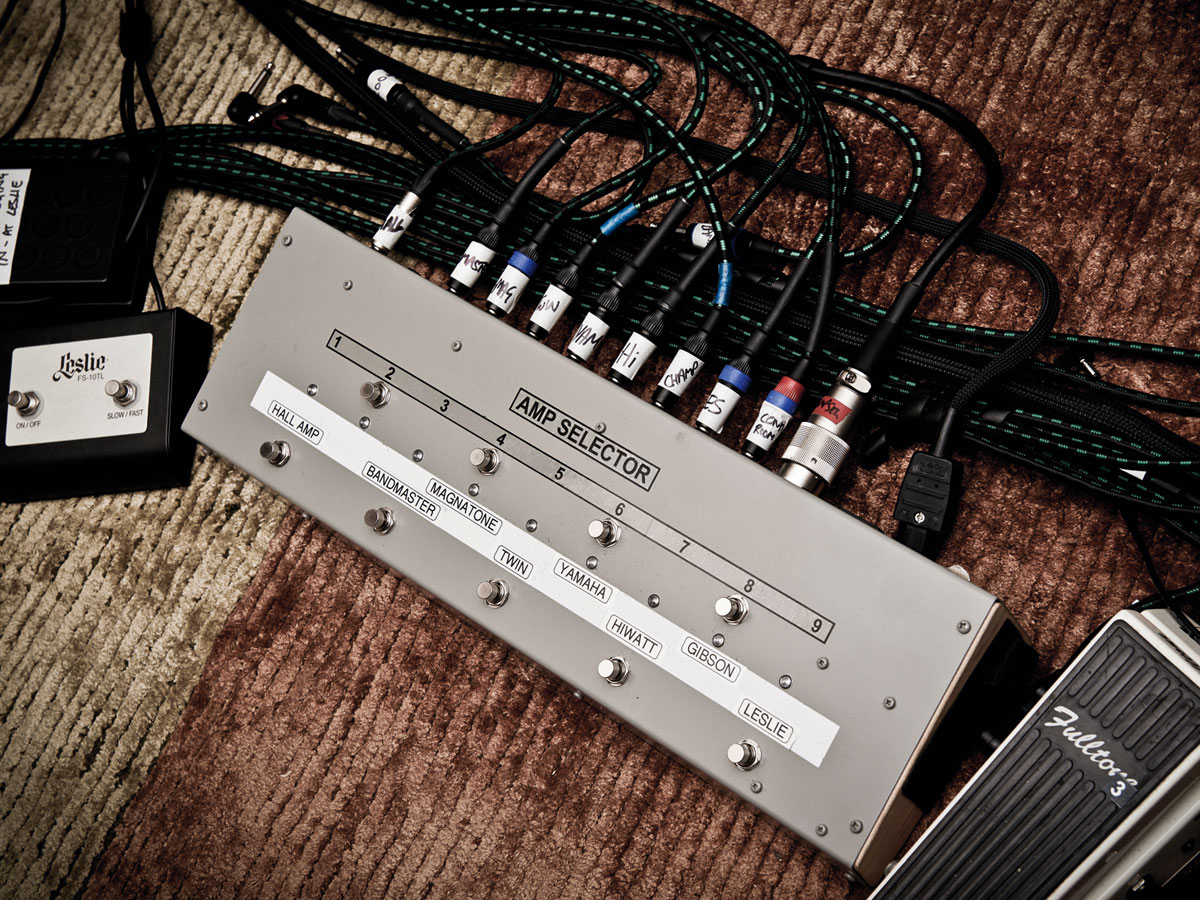
Custom switching - amps
A custom switching unit that is used to select the amps in the live room - this can also be done from the control room.
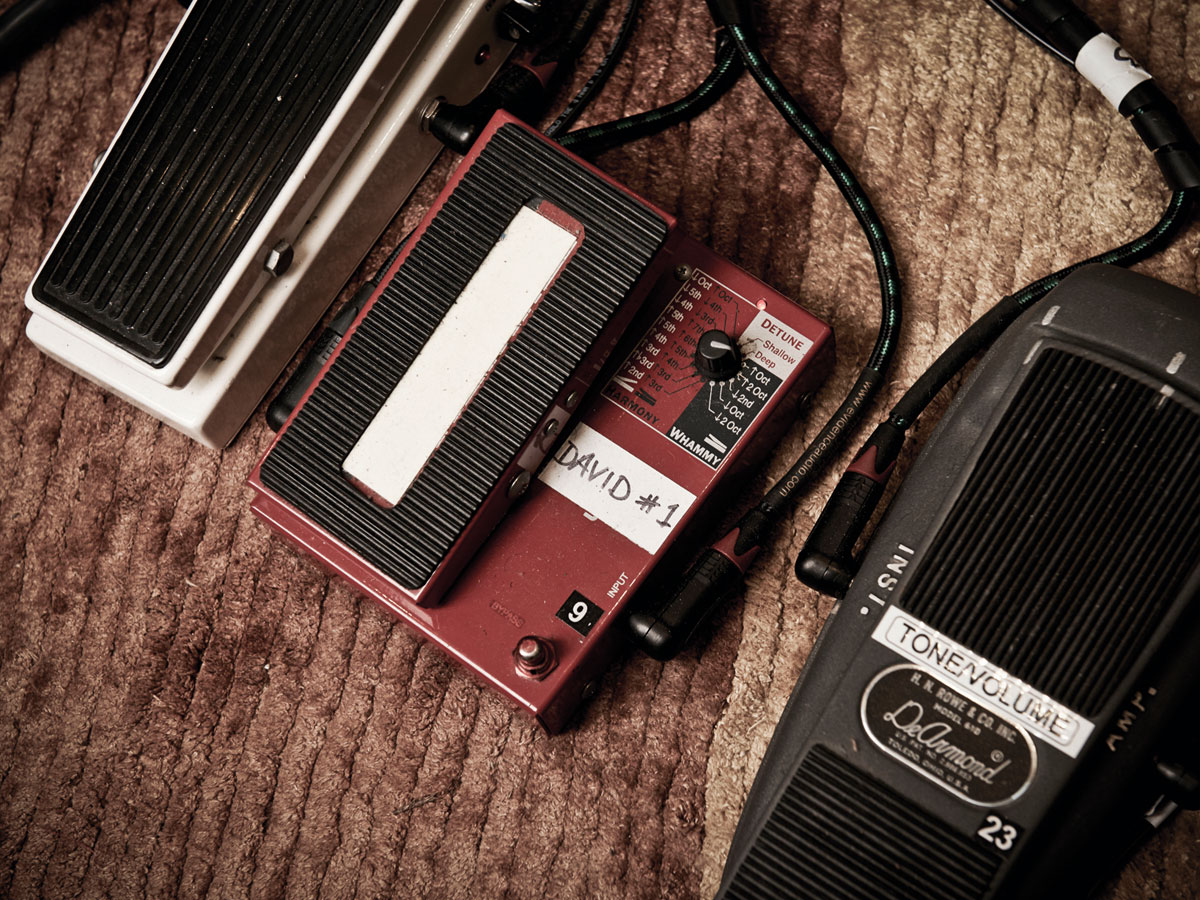
DigiTech Whammy
PT: “I’m sure your readers can work out what this 1990s Digitech Whammy pedal is on. At the 1993 recording sessions that became the basis of The Endless River - recording The Division Bell at the time - I changed a couple of pedals in David’s set-up. Just so he had something else to try.
"He’d never used a Whammy before. But out of that came Marooned - which won a Grammy"
"He’d never used a Whammy before. But out of that came Marooned - which won a Grammy. And there are bits of Whammy on The Endless River. He generally uses it in the ‘one octave up’ position. And that’s it. Is David playing slide, or is he playing a Whammy? Let’s leave a bit of mystique!”
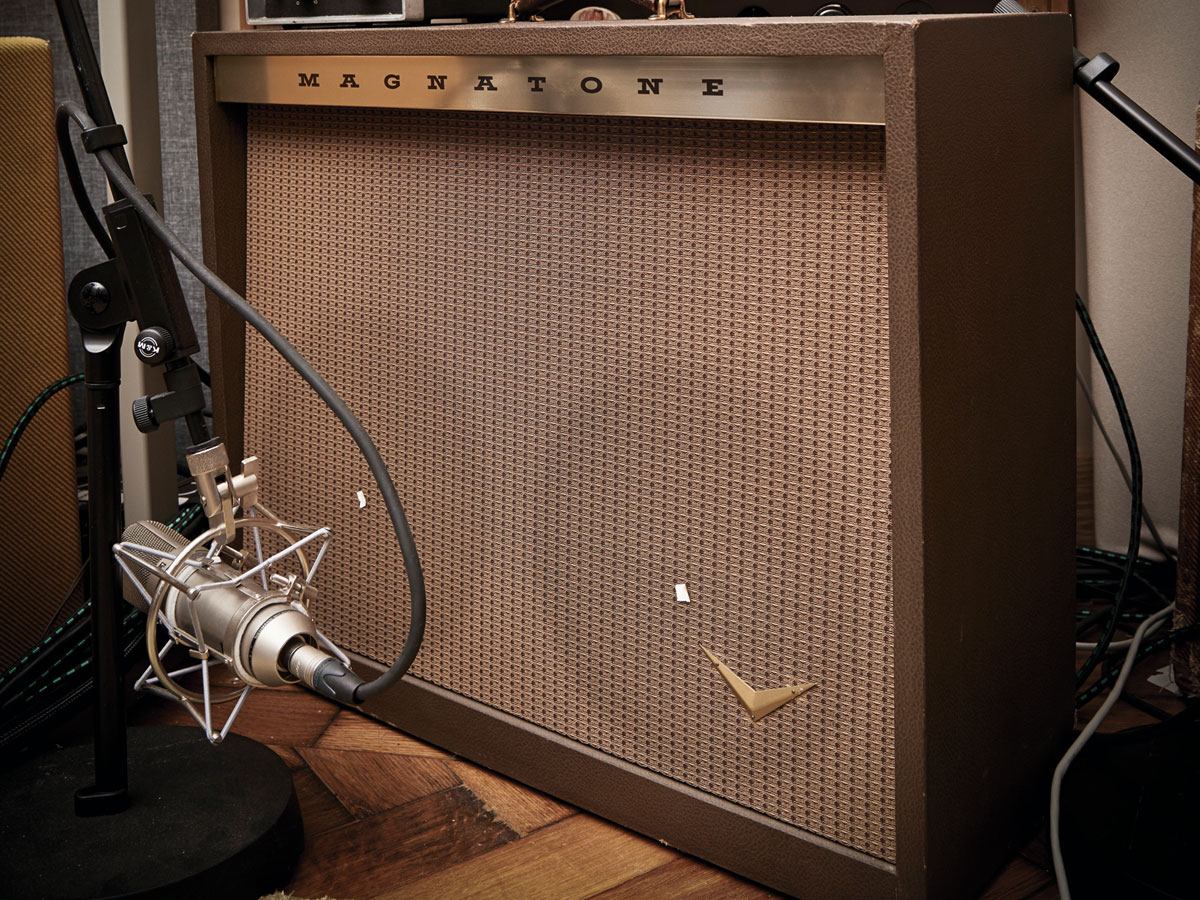
Magnatone 260
A vintage Magnatone 260 combo joins the Hiwatts and Fenders in the live room, further evidence of the regard in which amps by the US company, recently revived, are held.
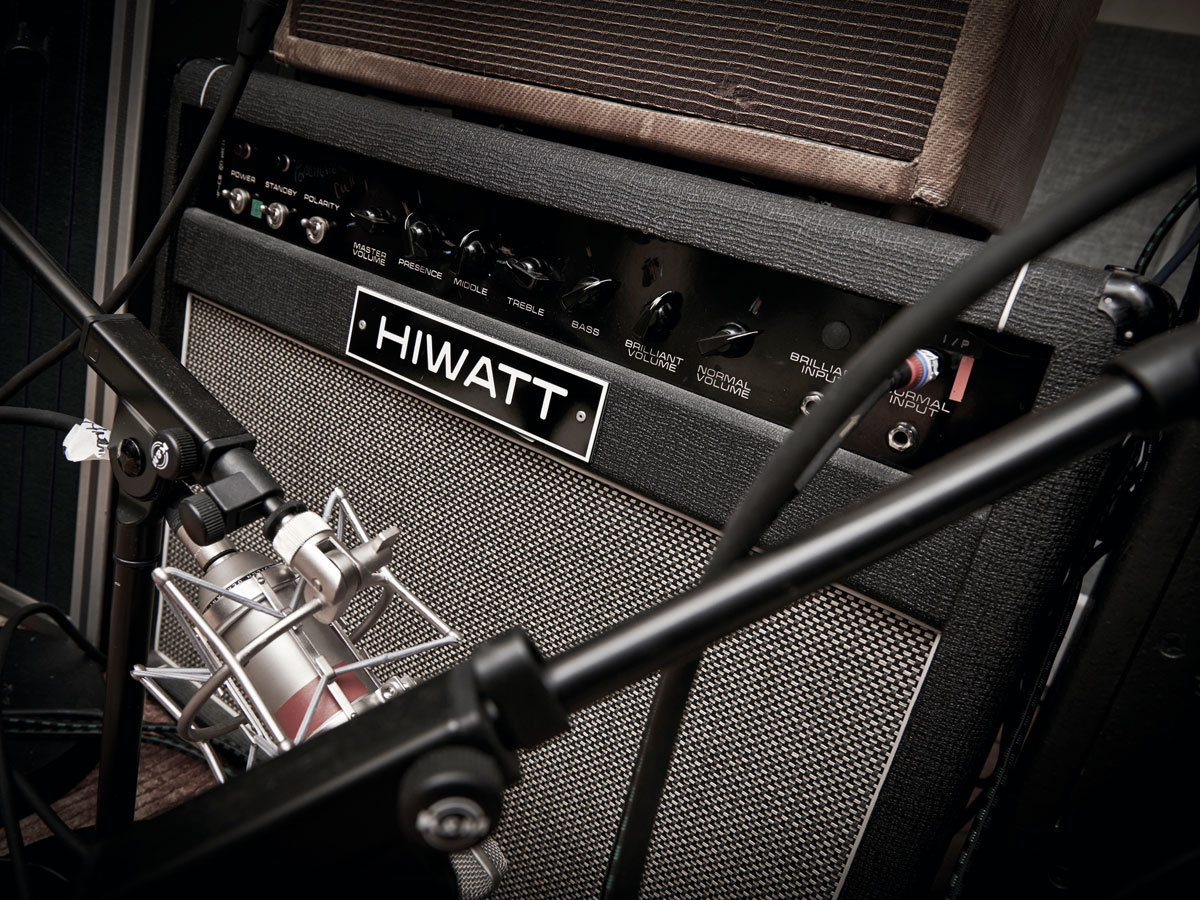
Hiwatt SA212
The Hiwatt SA212 combo is a staple of Gilmour’s recording rig. powered by a brace of el34s, it is fitted with Fane crescendo drivers.
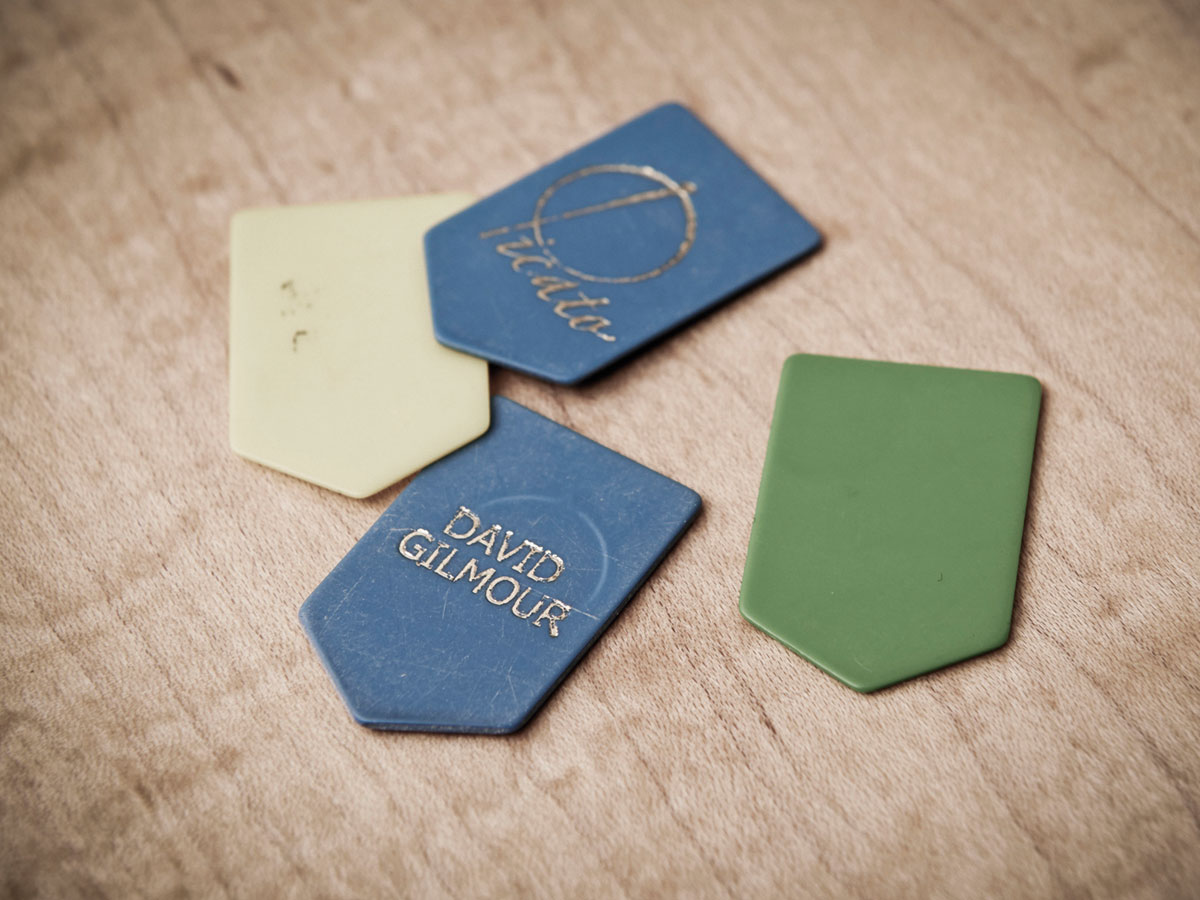
Picks
A handful of picks tells you who’s normally at home here in Medina...
“I’m beyond excited to introduce the next evolution of the MT15”: PRS announces refresh of tube amp lineup with the all-new Archon Classic and a high-gain power-up for the Mark Tremonti lunchbox head
“Its mission is simple: unleash the power of any amplifier or line-level source without compromise”: Two Notes promises a “watershed” in tube amp control with the Torpedo Reload II
“I’m beyond excited to introduce the next evolution of the MT15”: PRS announces refresh of tube amp lineup with the all-new Archon Classic and a high-gain power-up for the Mark Tremonti lunchbox head
“Its mission is simple: unleash the power of any amplifier or line-level source without compromise”: Two Notes promises a “watershed” in tube amp control with the Torpedo Reload II





![PRS Archon Classic and Mark Tremonti MT 15 v2: the newly redesigned tube amps offer a host of new features and tones, with the Alter Bridge guitarist's new lunchbox head [right] featuring the Overdrive channel from his MT 100 head, and there's a half-power switch, too.](https://cdn.mos.cms.futurecdn.net/FD37q5pRLCQDhCpT8y94Zi.jpg)





